This is an old revision of this page, as edited by Jonathansammy (talk | contribs) at 20:19, 8 December 2023 (Undid revision 1188938274 by Dympies (talk) The Mughal emperors were powerless for more than a century but all rulers including the Marathas and the British ruled their respective territories in the name of the emperor. Even the coins by these rulers were minted in the emperor's name). The present address (URL) is a permanent link to this revision, which may differ significantly from the current revision.
Revision as of 20:19, 8 December 2023 by Jonathansammy (talk | contribs) (Undid revision 1188938274 by Dympies (talk) The Mughal emperors were powerless for more than a century but all rulers including the Marathas and the British ruled their respective territories in the name of the emperor. Even the coins by these rulers were minted in the emperor's name)(diff) ← Previous revision | Latest revision (diff) | Newer revision → (diff) 1526–1857 empire in South Asia Not to be confused with the Mongol Empire or Moghulistan. "Mughals" redirects here. For the ethnic groups, see Mughal people.
| Mughal Empire | |||||||||||||||||
|---|---|---|---|---|---|---|---|---|---|---|---|---|---|---|---|---|---|
| 1526–1857 | |||||||||||||||||
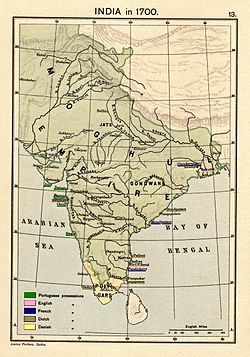 The empire at its greatest extent in c. 1700 under Aurangzeb The empire at its greatest extent in c. 1700 under Aurangzeb | |||||||||||||||||
| Status | Empire | ||||||||||||||||
| Capital |
| ||||||||||||||||
| Common languages |
| ||||||||||||||||
| Religion | State religion:
| ||||||||||||||||
| Government | Unitary absolute monarchy under a federal structure
| ||||||||||||||||
| Emperor | |||||||||||||||||
| • 1526–1530 (first) | Babur | ||||||||||||||||
| • 1837–1857 (last) | Bahadur Shah II | ||||||||||||||||
| Vakil-i-Mutlaq | |||||||||||||||||
| • 1526–1540 (first) | Mir Khalifa | ||||||||||||||||
| • 1795–1818 (last) | Daulat Rao Sindhia | ||||||||||||||||
| Grand Vizier | |||||||||||||||||
| • 1526–1540 (first) | Mir Khalifa | ||||||||||||||||
| • 1775–1797 (last) | Asaf-ud-Daula | ||||||||||||||||
| Historical era | Early modern | ||||||||||||||||
| • First Battle of Panipat | 21 April 1526 | ||||||||||||||||
| • Empire interrupted by Sur Empire | 1540–1555 | ||||||||||||||||
| • Second Battle of Panipat | 5 November 1556 | ||||||||||||||||
| • Mughal–Maratha Wars | 1680–1707 | ||||||||||||||||
| • Battle of Delhi followed by Battle of Bhopal | 28 March 1737 | ||||||||||||||||
| • Nader Shah's invasion of India | 10 May 1738–1740 | ||||||||||||||||
| • Battle of Buxar | 22 October 1764 | ||||||||||||||||
| • Siege of Delhi | 21 September 1857 | ||||||||||||||||
| • Mughal emperor tried and exiled to Burma | 1858 | ||||||||||||||||
| Area | |||||||||||||||||
| 1690 | 4,000,000 km (1,500,000 sq mi) | ||||||||||||||||
| Population | |||||||||||||||||
| • 1595 | 125,000,000 | ||||||||||||||||
| • 1700 | 158,000,000 | ||||||||||||||||
| Currency | Rupee, Taka, dam | ||||||||||||||||
| |||||||||||||||||
The Mughal Empire was an early modern empire in South Asia. At its peak, the empire stretched from the outer fringes of the Indus River Basin in the west, northern Afghanistan in the northwest, and Kashmir in the north, to the highlands of present-day Assam and Bangladesh in the east, and the uplands of the Deccan Plateau in South India.
The Mughal Empire is conventionally said to have been founded in 1526 by Babur, a chieftain from what is today Uzbekistan, who employed aid from the neighboring Safavid and Ottoman Empires, to defeat the Sultan of Delhi, Ibrahim Lodi, in the First Battle of Panipat, and to sweep down the plains of North India. The Mughal imperial structure, however, is sometimes dated to 1600, to the rule of Babur's grandson, Akbar. This imperial structure lasted until 1720, until shortly after the death of the last major emperor, Aurangzeb, during whose reign the empire also achieved its maximum geographical extent. Reduced subsequently to the region in and around Old Delhi by 1760, the empire was formally dissolved by the British Raj after the Indian Rebellion of 1857.
Although the Mughal Empire was created and sustained by military warfare, it did not vigorously suppress the cultures and peoples it came to rule; rather it equalized and placated them through new administrative practices, and diverse ruling elites, leading to more efficient, centralised, and standardized rule. The base of the empire's collective wealth was agricultural taxes, instituted by the third Mughal emperor, Akbar. These taxes, which amounted to well over half the output of a peasant cultivator, were paid in the well-regulated silver currency, and caused peasants and artisans to enter larger markets.
The relative peace maintained by the empire during much of the 17th century was a factor in India's economic expansion. The burgeoning European presence in the Indian Ocean and an increasing demand for Indian raw and finished products generated much wealth for the Mughal court. There was more conspicuous consumption among the Mughal elite, resulting in greater patronage of painting, literary forms, textiles, and architecture, especially during the reign of Shah Jahan. Among the Mughal UNESCO World Heritage Sites in South Asia are: Agra Fort, Fatehpur Sikri, Red Fort, Humayun's Tomb, Lahore Fort, Shalamar Gardens, and the Taj Mahal, which is described as "the jewel of Muslim art in India, and one of the universally admired masterpieces of the world's heritage."
Name
The closest to an official name for the empire was Hindustan, which was documented in the Ain-i-Akbari. Mughal administrative records also refer to the empire as "Land of Hindustan" (Template:Lang-fa), "Dominions of Hindustan" (Template:Lang-fa), or "Sultanate of Al-Hind" (Arabic: سلطنة الهندية, Saltanat(i) Al-Hindiyyah) as observed in the epithet of emperor Aurangzeb. Contemporary chronicles from Qing China referred to the empire as "Hindustan" (Chinese: 痕都斯坦, Héndōusītǎn; Manchu: Undustan). In the west, the term "Mughal" was used for the emperor, and by extension, the empire as a whole.
The Mughal designation for their own dynasty was Gurkani (Template:Lang-fa). The use of "Mughal" and "Moghul" derived from the Arabic and Persian corruption of "Mongol", and it emphasised the Mongol origins of the Timurid dynasty. The term gained currency during the 19th century, but remains disputed by Indologists. Similar transliterations had been used to refer to the empire, including "Mogul" and "Moghul". Babur's ancestors were distinguished from the classical Mongols insofar as they were oriented towards Persian rather than Turco-Mongol culture. Nevertheless, the Mughals themselves claimed ultimate descent from the founder of the Mongol Empire, Genghis Khan.
History
Main article: Mughal dynastyBabur and Humayun (1526–1556)
Main articles: Babur and Humayun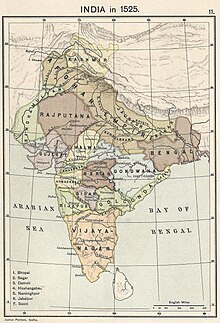
The Mughal Empire was founded by Babur (reigned 1526–1530), a Central Asian ruler who was descended from the Turco-Mongol conqueror Timur (the founder of the Timurid Empire) on his father's side, and from Genghis Khan on his mother's side. Paternally, Babur belonged to the Turkicized Barlas tribe of Mongol origin. Ousted from his ancestral domains in Central Asia, Babur turned to India to satisfy his ambitions. He established himself in Kabul and then pushed steadily southward into India from Afghanistan through the Khyber Pass. Babur's forces defeated Ibrahim Lodi in the First Battle of Panipat in 1526. Before the battle, Babur sought divine favour by abjuring liquor, breaking the wine vessels and pouring the wine down a well. However, by this time Lodi's empire was already crumbling, and it was actually the Rajput Confederacy which was the strongest power of Northern India under the capable rule of Rana Sanga of Mewar. He defeated Babur in the Battle of Bayana. However, in the decisive Battle of Khanwa which was fought near Agra, the Timurid forces of Babur defeated the Rajput army of Sanga. This battle was one of the most decisive and historic battles in Indian history, as it sealed the fate of Northern India for the next two centuries.
After the battle, the centre of Mughal power became Agra instead of Kabul. The preoccupation with wars and military campaigns, however, did not allow the new emperor to consolidate the gains he had made in India. The instability of the empire became evident under his son, Humayun (reigned 1530–1556), who was forced into exile in Persia by rebels. The Sur Empire (1540–1555), founded by Sher Shah Suri (reigned 1540–1545), briefly interrupted Mughal rule. Humayun's exile in Persia established diplomatic ties between the Safavid and Mughal Courts, and led to increasing Persian cultural influence in the later restored Mughal Empire. Humayun's triumphant return from Persia in 1555 restored Mughal rule in some parts of India, but he died in an accident the next year.
Akbar to Aurangzeb (1556–1707)
Main articles: Akbar, Jahangir, Shah Jahan, and Aurangzeb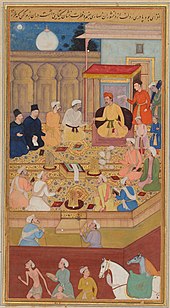
Akbar (reigned 1556–1605) was born Jalal-ud-din Muhammad in the Rajput Umarkot Fort, to Humayun and his wife Hamida Banu Begum, a Persian princess. Akbar succeeded to the throne under a regent, Bairam Khan, who helped consolidate the Mughal Empire in India. Through warfare and diplomacy, Akbar was able to extend the empire in all directions and controlled almost the entire Indian subcontinent north of the Godavari River. He created a new ruling elite loyal to him, implemented a modern administration, and encouraged cultural developments. He increased trade with European trading companies. India developed a strong and stable economy, leading to commercial expansion and economic development. Akbar allowed freedom of religion at his court, and attempted to resolve socio-political and cultural differences in his empire by establishing a new religion, Din-i-Ilahi, with strong characteristics of a ruler cult. He left his son an internally stable state, which was in the midst of its golden age, but before long signs of political weakness would emerge.
Jahangir (born Salim, reigned 1605–1627) was born to Akbar and his wife Mariam-uz-Zamani, an Indian Rajput princess. Salim was named after the Indian Sufi saint, Salim Chishti. He "was addicted to opium, neglected the affairs of the state, and came under the influence of rival court cliques". Jahangir distinguished himself from Akbar by making substantial efforts to gain the support of the Islamic religious establishment. One way he did this was by bestowing many more madad-i-ma'ash (tax-free personal land revenue grants given to religiously learned or spiritually worthy individuals) than Akbar had. In contrast to Akbar, Jahangir came into conflict with non-Muslim religious leaders, notably the Sikh guru Arjan, whose execution was the first of many conflicts between the Mughal empire and the Sikh community.
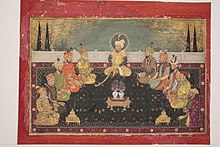
Shah Jahan (reigned 1628–1658) was born to Jahangir and his wife Jagat Gosain, a Rajput princess. His reign ushered in the golden age of Mughal architecture. During the reign of Shah Jahan, the splendour of the Mughal court reached its peak, as exemplified by the Taj Mahal.The cost of maintaining the court, however, began to exceed the revenue coming in. His reign was called as "The Golden Age of Mughal Architecture". Shah Jahan extended the Mughal empire to the Deccan by ending the Nizam Shahi dynasty, and forced the Adil Shahis and Qutb Shahis to pay tribute.
Shah Jahan's eldest son, the liberal Dara Shikoh, became regent in 1658, as a result of his father's illness. Dara championed a syncretistic Hindu-Muslim culture, emulating his great-grandfather Akbar. With the support of the Islamic orthodoxy, however, a younger son of Shah Jahan, Aurangzeb (r. 1658–1707), seized the throne. Aurangzeb defeated Dara in 1659 and had him executed. Although Shah Jahan fully recovered from his illness, Aurangzeb kept Shah Jahan imprisoned until his death in 1666. Aurangzeb oversaw an increase in the Islamicization of the Mughal state. He encouraged conversion to Islam, reinstated the jizya on non-Muslims, and compiled the Fatawa 'Alamgiri, a collection of Islamic law. Aurangzeb also ordered the execution of the Sikh guru Tegh Bahadur, leading to the militarization of the Sikh community. From the imperial perspective, conversion to Islam integrated local elites into the king's vision of network of shared identity that would join disparate groups throughout the empire in obedience to the Mughal emperor. His campaign to conquer South and Western India nominally increased the size of Mughal Empire, but had a ruinous effect on Mughal Empire. Matthew White estimates that about 2.5 million of Aurangzeb's army were killed during the Mughal–Maratha Wars (100,000 annually during a quarter-century), while 2 million civilians in war-torn lands died due to drought, plague and famine. This campaign also had a ruinous effect on Mughal Treasury, and Emperor's absence led to a severe decline in Governance in Northern India. Marathas started expanding northwards shortly after the death of Aurangzeb, defeated the Mughals in Delhi and Bhopal, and extended their empire up to Peshawar by 1758.
Aurangzeb is considered India's most controversial king, with some historians arguing his religious conservatism and intolerance undermined the stability of Mughal society, while other historians question this, noting that he built Hindu temples, employed significantly more Hindus in his imperial bureaucracy than his predecessors did, opposed bigotry against Hindus and Shia Muslims. Despite these allegations, it has been acknowledged that Emperor Aurangzeh enacted repressive policies towards non-Muslims, which also resulted to a major rebellion by the Marathas.
Decline (1707–1857)
Further information: Bahadur Shah Zafar

Aurangzeb's son, Bahadur Shah I, repealed the religious policies of his father and attempted to reform the administration. "However, after his death in 1712, the Mughal dynasty began to sink into chaos and violent feuds. In 1719 alone, four emperors successively ascended the throne", as figureheads under the rule of a brotherhood of nobles belonging to the Indian Muslim caste known as the Sadaat-e-Bara, whose leaders, the Sayyid Brothers, became the de facto sovereigns of the empire.
During the reign of Muhammad Shah (reigned 1719–1748), the empire began to break up, and vast tracts of central India passed from Mughal to Maratha hands. As the Mughals tried to suppress the independence of the Nizam in the Deccan, he encouraged the Marathas to invade central and northern India. The far-off Indian campaign of Nader Shah, who had previously reestablished Iranian suzerainty over most of West Asia, the Caucasus, and Central Asia, culminated with the Sack of Delhi and shattered the remnants of Mughal power and prestige. Many of the empire's elites now sought to control their own affairs, and broke away to form independent kingdoms. But, according to Sugata Bose and Ayesha Jalal, the Mughal Emperor continued to be the highest manifestation of sovereignty. Not only the Muslim gentry, but the Maratha, Hindu, and Sikh leaders took part in ceremonial acknowledgments of the emperor as the sovereign of India.
Meanwhile, some regional polities within the increasingly fragmented Mughal Empire, involved themselves and the state in global conflicts, leading only to defeat and loss of territory during the Carnatic Wars and the Bengal War.
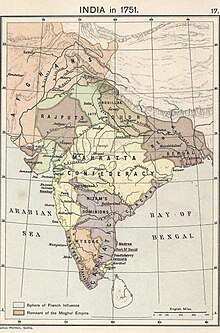
The Mughal Emperor Shah Alam II (1759–1806) made futile attempts to reverse the Mughal decline but ultimately had to seek the protection of the Emir of Afghanistan, Ahmed Shah Abdali, which led to the Third Battle of Panipat between the Maratha Empire and the Afghans (led by Abdali) in 1761. In 1771, the Marathas recaptured Delhi from Afghan control and in 1784 they officially became the protectors of the emperor in Delhi, a state of affairs that continued until the Second Anglo-Maratha War. Thereafter, the British East India Company became the protectors of the Mughal dynasty in Delhi. The British East India Company took control of the former Mughal province of Bengal-Bihar in 1793 after it abolished local rule (Nizamat) that lasted until 1858, marking the beginning of British colonial era over the Indian subcontinent. By 1857 a considerable part of former Mughal India was under the East India Company's control. After a crushing defeat in the war of 1857–1858 which he nominally led, the last Mughal, Bahadur Shah Zafar, was deposed by the British East India Company and exiled in 1858. Zafar was exiled to Rangoon, Burma. His wife Zeenat Mahal and some of the remaining members of the family accompanied him. At 4 am on 7 October 1858, Zafar along with his wives, two remaining sons began his journey towards Rangoon in bullock carts escorted by 9th Lancers under command of Lieutenant Ommaney. Through the Government of India Act 1858 the British Crown assumed direct control of East India Company-held territories in India in the form of the new British Raj. In 1876 the British Queen Victoria assumed the title of Empress of India.
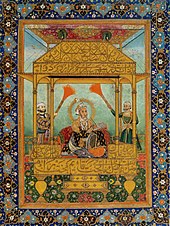
Causes of decline
Historians have offered numerous explanations for the rapid collapse of the Mughal Empire between 1707 and 1720, after a century of growth and prosperity. In fiscal terms, the throne lost the revenues needed to pay its chief officers, the emirs (nobles) and their entourages. The emperor lost authority, as the widely scattered imperial officers lost confidence in the central authorities, and made their own deals with local men of influence. The imperial army, bogged down in long, futile wars against the more aggressive Marathas, lost its fighting spirit. Finally came a series of violent political feuds over control of the throne. After the execution of Emperor Farrukhsiyar in 1719, local Mughal successor states took power in region after region.
Contemporary chroniclers bewailed the decay they witnessed, a theme picked up by the first British historians who wanted to underscore the need for a British-led rejuvenation.
Modern views on the decline
Since the 1970s historians have taken multiple approaches to the decline, with little consensus on which factor was dominant. The psychological interpretations emphasise depravity in high places, excessive luxury, and increasingly narrow views that left the rulers unprepared for an external challenge. A Marxist school (led by Irfan Habib and based at Aligarh Muslim University) emphasises excessive exploitation of the peasantry by the rich, which stripped away the will and the means to support the regime. Karen Leonard has focused on the failure of the regime to work with Hindu bankers, whose financial support was increasingly needed; the bankers then helped the Maratha and the British. In a religious interpretation, some scholars argue that the Hindu powers revolted against the rule of a Muslim dynasty. Finally, other scholars argue that the very prosperity of the Empire inspired the provinces to achieve a high degree of independence, thus weakening the imperial court.
Jeffrey G. Williamson has argued that the Indian economy went through deindustrialization in the latter half of the 18th century as an indirect outcome of the collapse of the Mughal Empire, with British rule later causing further deindustrialization. According to Williamson, the decline of the Mughal Empire led to a decline in agricultural productivity, which drove up food prices, then nominal wages, and then textile prices, which led to India losing a share of the world textile market to Britain even before it had superior factory technology. Indian textiles, however, still maintained a competitive advantage over British textiles up until the 19th century.
Administration and state
Main article: Government of the Mughal Empire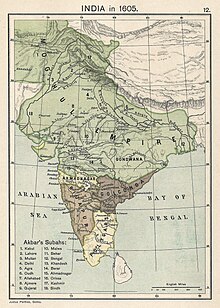
The Mughal Empire had a highly centralised, bureaucratic government, most of which was instituted during the rule of the third Mughal emperor Akbar. The central government was headed by the Mughal emperor; immediately beneath him were four ministries. The finance/revenue ministry, headed by an official called a diwan, was responsible for controlling revenues from the empire's territories, calculating tax revenues, and using this information to distribute assignments. The ministry of the military (army/intelligence) was headed by an official titled mir bakhshi, who was in charge of military organisation, messenger service, and the mansabdari system. The ministry in charge of law/religious patronage was the responsibility of the sadr as-sudr, who appointed judges and managed charities and stipends. Another ministry was dedicated to the imperial household and public works, headed by the mir saman. Of these ministers, the diwan held the most importance, and typically acted as the wazir (prime minister) of the empire.
Administrative divisions
The empire was divided into Subah (provinces), each of which were headed by a provincial governor called a subadar. The structure of the central government was mirrored at the provincial level; each suba had its own bakhshi, sadr as-sudr, and finance minister that reported directly to the central government rather than the subahdar. Subas were subdivided into administrative units known as sarkars, which were further divided into groups of villages known as parganas. Mughal government in the pargana consisted of a Muslim judge and local tax collector. Parganas were the basic administrative unit of the Mughal empire.
Mughal administrative divisions were not static. Territories were often rearranged and reconstituted for better administrative control, and to extend cultivation. For example, a sarkar could turn into a subah, and parganas were often transferred between sarkars. The hierarchy of division was ambiguous sometimes, as a territory could fall under multiple overlapping jurisdictions. Administrative divisions were also vague in their geography – the Mughal state did not have enough resources or authority to undertake detailed land surveys, and hence the geographical limits of these divisions were not formalised and maps not created. The Mughals instead recorded detailed statistics about each division, in order to assess the territory's capacity for revenue, on the basis of simpler land surveys.
Capitals
The Mughals had multiple imperial capitals, established over the course of their rule. These were the cities of Agra, Delhi, Lahore, and Fatehpur Sikri. Power often shifted back and forth between these capitals. Sometimes this was necessitated by political and military demands, but shifts also occurred for ideological reasons (for example, Akbar's establishment of Fatehpur Sikri), or even simply because the cost of establishing a new capital was marginal. Situations where there were two simultaneous capitals happened multiple times in Mughal history. Certain cities also served as short-term, provincial capitals, as was the case with Aurangzeb's shift to Aurangabad in the Deccan. Kabul was the summer capital of Mughals from 1526 to 1681.
The imperial camp, used for military expeditions and royal tours, also served as a kind of mobile, "de facto" administrative capital. From the time of Akbar, Mughal camps were huge in scale, accompanied by numerous personages associated with the royal court, as well as soldiers and labourers. All administration and governance was carried out within them. The Mughal Emperors spent a significant portion of their ruling period within these camps.
After Aurangzeb, the Mughal capital definitively became the walled city of Shahjahanabad (Old Delhi).
Law
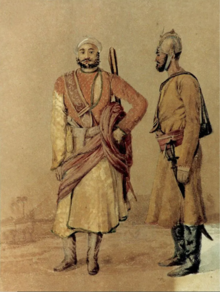
The Mughal Empire's legal system was context-specific and evolved over the course of the empire's rule. Being a Muslim state, the empire employed fiqh (Islamic jurisprudence) and therefore the fundamental institutions of Islamic law such as those of the qadi (judge), mufti (jurisconsult), and muhtasib (censor and market supervisor) were well-established in the Mughal Empire. However, the dispensation of justice also depended on other factors, such as administrative rules, local customs, and political convenience. This was due to Persianate influences on Mughal ideology, and the fact that the Mughal Empire governed a non-Muslim majority. Scholar Mouez Khalfaoui notes that legal institutions in the Mughal Empire systemically suffered from the corruption of local judges.
Legal ideology
The Mughal Empire followed the Sunni Hanafi system of jurisprudence. In its early years, the empire relied on Hanafi legal references inherited from its predecessor, the Delhi Sultanate. These included the al-Hidayah (the best guidance) and the Fatawa al-Tatarkhaniyya (religious decisions of the Emire Tatarkhan). During the Mughal Empire's peak, the Fatawa 'Alamgiri was commissioned by Emperor Aurangzeb. This compendium of Hanafi law sought to serve as a central reference for the Mughal state that dealt with the specifics of the South Asian context.
The Mughal Empire also drew on Persianate notions of kingship. Particularly, this meant that the Mughal emperor was considered the supreme authority on legal affairs.
Courts of law
Various kinds of courts existed in the Mughal empire. One such court was that of the qadi. The Mughal qadi was responsible for dispensing justice; this included settling disputes, judging people for crimes, and dealing with inheritances and orphans. The qadi also had additional importance with regards to documents, as the seal of the qadi was required to validate deeds and tax records. Qadis did not constitute a single position, but made up a hierarchy. For example, the most basic kind was the pargana (district) qadi. More prestigious positions were those of the qadi al-quddat (judge of judges) who accompanied the mobile imperial camp, and the qadi-yi lashkar (judge of the army). Qadis were usually appointed by the emperor or the sadr-us-sudr (chief of charities). The jurisdiction of the qadi was availed by Muslims and non-Muslims alike.
The jagirdar (local tax collector) was another kind of official approached, especially for high-stakes cases. Subjects of the Mughal Empire also took their grievances to the courts of superior officials who held more authority and punitive power than the local qadi. Such officials included the kotwal (local police), the faujdar (an officer controlling multiple districts and troops of soldiers), and the most powerful, the subahdar (provincial governor). In some cases, the emperor themself dispensed justice directly. Jahangir was known to have installed a "chain of justice" in the Agra Fort that any aggrieved subject could shake to get the attention of the emperor and bypass the inefficacy of officials.
Self-regulating tribunals operating at the community or village level were common, but sparse documentation of them exists. For example, it is unclear how panchayats (village councils) operated in the Mughal era.
Economy
Main article: Economy of the Mughal EmpireThe economy in the Indian Subcontinent during the Mughal era performed just as it did in ancient times, though now it would face the stress of extensive regional tensions. The Mughal economy was large and prosperous. India was producing 24.5% of the world's manufacturing output up until 1750. India's economy has been described as a form of proto-industrialization, like that of 18th-century Western Europe prior to the Industrial Revolution.
The Mughals were responsible for building an extensive road system, creating a uniform currency, and the unification of the country. The empire had an extensive road network, which was vital to the economic infrastructure, built by a public works department set up by the Mughals which designed, constructed and maintained roads linking towns and cities across the empire, making trade easier to conduct.
The main base of the empire's collective wealth was agricultural taxes, instituted by the third Mughal emperor, Akbar. These taxes, which amounted to well over half the output of a peasant cultivator, were paid in the well-regulated silver currency, and caused peasants and artisans to enter larger markets.
Coinage
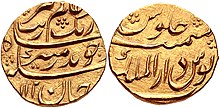
The Mughals adopted and standardised the rupee (rupiya, or silver) and dam (copper) currencies introduced by Sur Emperor Sher Shah Suri during his brief rule. The currency was initially 48 dams to a single rupee in the beginning of Akbar's reign, before it later became 38 dams to a rupee in the 1580s, with the dam's value rising further in the 17th century as a result of new industrial uses for copper, such as in bronze cannons and brass utensils. The dam was initially the most common coin in Akbar's time, before being replaced by the rupee as the most common coin in succeeding reigns. The dam's value was later worth 30 to a rupee towards the end of Jahangir's reign, and then 16 to a rupee by the 1660s. The Mughals minted coins with high purity, never dropping below 96%, and without debasement until the 1720s.
Despite India having its own stocks of gold and silver, the Mughals produced minimal gold of their own, but mostly minted coins from imported bullion, as a result of the empire's strong export-driven economy, with global demand for Indian agricultural and industrial products drawing a steady stream of precious metals into India. Around 80% of Mughal India's imports were bullion, mostly silver, with major sources of imported bullion including the New World and Japan, which in turn imported large quantities of textiles and silk from the Bengal Subah province.
Labour
The historian Shireen Moosvi estimates that in terms of contributions to the Mughal economy, in the late 16th century, the primary sector contributed 52%, the secondary sector 18% and the tertiary sector 29%; the secondary sector contributed a higher percentage than in early 20th-century British India, where the secondary sector only contributed 11% to the economy. In terms of urban-rural divide, 18% of Mughal India's labour force were urban and 82% were rural, contributing 52% and 48% to the economy, respectively.
According to Stephen Broadberry and Bishnupriya Gupta, grain wages in India were comparable to England in the 16th and 17th centuries, but diverged in the 18th century when they fell to 20-40% of England's wages. This, however, is disputed by Parthasarathi and Sivramkrishna. Parthasarathi cites his estimates that grain wages for weaving and spinning in mid-18 century Bengal and South India was comparable to Britain. Similarly, Sivramkrishna analyzed agricultural surveys conducted in Mysore by Francis Buchanan during 1800–1801, arrived at estimates using a "subsistence basket" that aggregated millet income could be almost five times subsistence level, while corresponding rice income was three times that much. That could be comparable to advance part of Europe. Due to the scarcity of data, however, more research is needed before drawing any conclusion.
According to Moosvi, Mughal India had a per-capita income, in terms of wheat, 1.24% higher in the late 16th century than British India did in the early 20th century. This income, however, would have to be revised downwards if manufactured goods, like clothing, would be considered. Compared to food per-capita, expenditure on clothing was much smaller though, so relative income between 1595 and 1596 should be comparable to 1901–1910. However, in a system where wealth was hoarded by elites, wages were depressed for manual labour. In Mughal India, there was a generally tolerant attitude towards manual labourers, with some religious cults in northern India proudly asserting a high status for manual labour. While slavery also existed, it was limited largely to household servants.
Agriculture
Indian agricultural production increased under the Mughal Empire. A variety of crops were grown, including food crops such as wheat, rice, and barley, and non-food cash crops such as cotton, indigo and opium. By the mid-17th century, Indian cultivators begun to extensively grow two new crops from the Americas, maize and tobacco.
The Mughal administration emphasised agrarian reform, which began under the non-Mughal emperor Sher Shah Suri, the work of which Akbar adopted and furthered with more reforms. The civil administration was organised in a hierarchical manner on the basis of merit, with promotions based on performance. The Mughal government funded the building of irrigation systems across the empire, which produced much higher crop yields and increased the net revenue base, leading to increased agricultural production.
A major Mughal reform introduced by Akbar was a new land revenue system called zabt. He replaced the tribute system, previously common in India and used by Tokugawa Japan at the time, with a monetary tax system based on a uniform currency. The revenue system was biased in favour of higher value cash crops such as cotton, indigo, sugar cane, tree-crops, and opium, providing state incentives to grow cash crops, in addition to rising market demand. Under the zabt system, the Mughals also conducted extensive cadastral surveying to assess the area of land under plow cultivation, with the Mughal state encouraging greater land cultivation by offering tax-free periods to those who brought new land under cultivation. The expansion of agriculture and cultivation continued under later Mughal emperors including Aurangzeb, whose 1665 firman edict stated: "the entire elevated attention and desires of the Emperor are devoted to the increase in the population and cultivation of the Empire and the welfare of the whole peasantry and the entire people."
Mughal agriculture was in some ways advanced compared to European agriculture at the time, exemplified by the common use of the seed drill among Indian peasants before its adoption in Europe. While the average peasant across the world was only skilled in growing very few crops, the average Indian peasant was skilled in growing a wide variety of food and non-food crops, increasing their productivity. Indian peasants were also quick to adapt to profitable new crops, such as maize and tobacco from the New World being rapidly adopted and widely cultivated across Mughal India between 1600 and 1650. Bengali farmers rapidly learned techniques of mulberry cultivation and sericulture, establishing Bengal Subah as a major silk-producing region of the world. Sugar mills appeared in India shortly before the Mughal era. Evidence for the use of a draw bar for sugar-milling appears at Delhi in 1540, but may also date back earlier, and was mainly used in the northern Indian subcontinent. Geared sugar rolling mills first appeared in Mughal India, using the principle of rollers as well as worm gearing, by the 17th century.
According to economic historian Immanuel Wallerstein, citing evidence from Irfan Habib, Percival Spear, and Ashok Desai, per-capita agricultural output and standards of consumption in 17th-century Mughal India were probably higher than in 17th-century Europe and certainly higher than early 20th-century British India. The increased agricultural productivity led to lower food prices. In turn, this benefited the Indian textile industry. Compared to Britain, the price of grain was about one-half in South India and one-third in Bengal, in terms of silver coinage. This resulted in lower silver coin prices for Indian textiles, giving them a price advantage in global markets.
Industrial manufacturing
Up until 1750, India produced about 25% of the world's industrial output. Manufactured goods and cash crops from the Mughal Empire were sold throughout the world. Key industries included textiles, shipbuilding, and steel. Processed products included cotton textiles, yarns, thread, silk, jute products, metalware, and foods such as sugar, oils and butter. The growth of manufacturing industries in the Indian subcontinent during the Mughal era in the 17th–18th centuries has been referred to as a form of proto-industrialization, similar to 18th-century Western Europe prior to the Industrial Revolution.
In early modern Europe, there was significant demand for products from Mughal India, particularly cotton textiles, as well as goods such as spices, peppers, indigo, silks, and saltpeter (for use in munitions). European fashion, for example, became increasingly dependent on Mughal Indian textiles and silks. From the late 17th century to the early 18th century, Mughal India accounted for 95% of British imports from Asia, and the Bengal Subah province alone accounted for 40% of Dutch imports from Asia. In contrast, there was very little demand for European goods in Mughal India, which was largely self-sufficient, thus Europeans had very little to offer, except for some woolens, unprocessed metals and a few luxury items. The trade imbalance caused Europeans to export large quantities of gold and silver to Mughal India in order to pay for South Asian imports. Indian goods, especially those from Bengal, were also exported in large quantities to other Asian markets, such as Indonesia and Japan.
Textile industry
See also: Muslin trade in Bengal and Mughal clothing

The largest manufacturing industry in the Mughal Empire was textile manufacturing, particularly cotton textile manufacturing, which included the production of piece goods, calicos, and muslins, available unbleached and in a variety of colours. The cotton textile industry was responsible for a large part of the empire's international trade. India had a 25% share of the global textile trade in the early 18th century. Indian cotton textiles were the most important manufactured goods in world trade in the 18th century, consumed across the world from the Americas to Japan. By the early 18th century, Mughal Indian textiles were clothing people across the Indian subcontinent, Southeast Asia, Europe, the Americas, Africa, and the Middle East. The most important centre of cotton production was the Bengal province, particularly around its capital city of Dhaka.
Bengal accounted for more than 50% of textiles and around 80% of silks imported by the Dutch from Asia, Bengali silk and cotton textiles were exported in large quantities to Europe, Indonesia, and Japan, and Bengali muslin textiles from Dhaka were sold in Central Asia, where they were known as "Dhaka textiles". Indian textiles dominated the Indian Ocean trade for centuries, were sold in the Atlantic Ocean trade, and had a 38% share of the West African trade in the early 18th century, while Indian calicos were a major force in Europe, and Indian textiles accounted for 20% of total English trade with Southern Europe in the early 18th century.
The worm gear roller cotton gin, which was invented in India during the early Delhi Sultanate era of the 13th–14th centuries, came into use in the Mughal Empire sometime around the 16th century, and is still used in India through to the present day. Another innovation, the incorporation of the crank handle in the cotton gin, first appeared in India sometime during the late Delhi Sultanate or the early Mughal Empire. The production of cotton, which may have largely been spun in the villages and then taken to towns in the form of yarn to be woven into cloth textiles, was advanced by the diffusion of the spinning wheel across India shortly before the Mughal era, lowering the costs of yarn and helping to increase demand for cotton. The diffusion of the spinning wheel, and the incorporation of the worm gear and crank handle into the roller cotton gin led to greatly expanded Indian cotton textile production during the Mughal era.
Once, the Mughal emperor Akbar asked his courtiers, which was the most beautiful flower. Some said rose, from whose petals were distilled the precious ittar, others, the lotus, glory of every Indian village. But Birbal said, "The cotton boll". There was a scornful laughter and Akbar asked for an explanation. Birbal said, "Your Majesty, from the cotton boll comes the fine fabric prized by merchants across the seas that has made your empire famous throughout the world. The perfume of your fame far exceeds the scent of roses and jasmine. That is why I say the cotton boll is the most beautiful flower.
Bengal Subah
Main article: Bengal Subah See also: Muslin trade in Bengal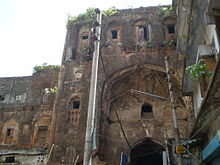
The Bengal Subah province was especially prosperous from the time of its takeover by the Mughals in 1590 until the British East India Company seized control in 1757. Historian C. A. Bayly wrote that it was probably the Mughal Empire's wealthiest province. Domestically, much of India depended on Bengali products such as rice, silks and cotton textiles. Overseas, Europeans depended on Bengali products such as cotton textiles, silks, and opium; Bengal accounted for 40% of Dutch imports from Asia, for example, including more than 50% of textiles and around 80% of silks. From Bengal, saltpeter was also shipped to Europe, opium was sold in Indonesia, raw silk was exported to Japan and the Netherlands, and cotton and silk textiles were exported to Europe, Indonesia and Japan. Akbar played a key role in establishing Bengal as a leading economic centre, as he began transforming many of the jungles there into farms. As soon as he conquered the region, he brought tools and men to clear jungles in order to expand cultivation and brought Sufis to open the jungles to farming. Bengal was later described as the Paradise of Nations by Mughal emperors. The Mughals introduced agrarian reforms, including the modern Bengali calendar. The calendar played a vital role in developing and organising harvests, tax collection and Bengali culture in general, including the New Year and Autumn festivals. The province was a leading producer of grains, salt, fruits, liquors and wines, precious metals and ornaments.
After 150 years of rule by Mughal viceroys, Bengal gained semi-independence as a dominion under the Nawab of Bengal in 1717. The Nawabs permitted European companies to set up trading posts across the region, including firms from Britain, France, the Netherlands, Denmark, Portugal and Austria. An Armenian community dominated banking and shipping in major cities and towns. The Europeans regarded Bengal as the richest place for trade. By the late 18th century, the British displaced the Mughal ruling class in Bengal.
Shipbuilding industry
Mughal India had a large shipbuilding industry, which was also largely centred in the Bengal province. Economic historian Indrajit Ray estimates shipbuilding output of Bengal during the sixteenth and seventeenth centuries at 223,250 tons annually, compared with 23,061 tons produced in nineteen colonies in North America from 1769 to 1771. He also assesses ship repairing as very advanced in Bengal.
An important innovation in shipbuilding was the introduction of a flushed deck design in Bengal rice ships, resulting in hulls that were stronger and less prone to leak than the structurally weak hulls of traditional European ships built with a stepped deck design. The British East India Company later duplicated the flushed deck and hull designs of Bengal rice ships in the 1760s, leading to significant improvements in seaworthiness and navigation for European ships during the Industrial Revolution.
Demographics
See also: Demographics of India: HistoryPopulation
India's population growth accelerated under the Mughal Empire, with an unprecedented economic and demographic upsurge which boosted the Indian population by 60% to 253% in 200 years during 1500–1700. The Indian population had a faster growth during the Mughal era than at any known point in Indian history prior to the Mughal era. By the time of Aurangzeb's reign, there were a total of 455,698 villages in the Mughal Empire.
The following table gives population estimates for the Mughal Empire, compared to the total population of South Asia including the regions of modern India, Pakistan, and Bangladesh, and compared to the world population:
| Year | Mughal Empire population |
Total Indian population |
% of South Asian population |
World population |
% of world population |
|---|---|---|---|---|---|
| 1500 | — | 100,000,000 | — | 425,000,000 | — |
| 1600 | 115,000,000 | 130,000,000 | 89 | 579,000,000 | 20 |
| 1700 | 158,400,000 | 160,000,000 | 99 | 679,000,000 | 23 |
Urbanization
According to Irfan Habib Cities and towns boomed under the Mughal Empire, which had a relatively high degree of urbanization for its time, with 15% of its population living in urban centres. This was higher than the percentage of the urban population in contemporary Europe at the time and higher than that of British India in the 19th century; the level of urbanization in Europe did not reach 15% until the 19th century.
Under Akbar's reign in 1600, the Mughal Empire's urban population was up to 17 million people, 15% of the empire's total population. This was larger than the entire urban population in Europe at the time, and even a century later in 1700, the urban population of England, Scotland and Wales did not exceed 13% of its total population, while British India had an urban population that was under 13% of its total population in 1800 and 9% in 1881, a decline from the earlier Mughal era. By 1700, Mughal India had an urban population of 23 million people, larger than British India's urban population of 22.3 million in 1871.
Those estimates were criticised by Tim Dyson, who consider them exaggerations. According to Dyson urbanization of Mughal empire was less than 9%.
The historian Nizamuddin Ahmad (1551–1621) reported that, under Akbar's reign, there were 120 large cities and 3200 townships. A number of cities in India had a population between a quarter-million and half-million people, with larger cities including Agra (in Agra Subah) with up to 800,000 people, Lahore (in Lahore Subah) with up to 700,000 people, Dhaka (in Bengal Subah) with over 1 million people, and Delhi (in Delhi Subah) with over 600,000 people.
Cities acted as markets for the sale of goods, and provided homes for a variety of merchants, traders, shopkeepers, artisans, moneylenders, weavers, craftspeople, officials, and religious figures. However, a number of cities were military and political centres, rather than manufacturing or commerce centres.
Culture
See also: Indo-Persian culture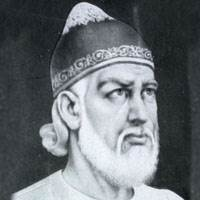
The Mughal Empire was definitive in the early-modern and modern periods of South Asian history, with its legacy in India, Pakistan, Bangladesh and Afghanistan seen in cultural contributions such as:

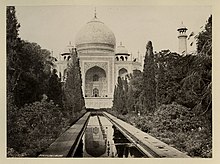
- Centralised imperial rule that consolidated the smaller polities of South Asia.
- The amalgamation of Persian art and literature with Indian art.
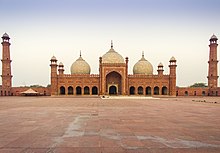
- The development of Mughlai cuisine, an amalgamation of South Asian, Iranian and Central Asian culinary styles.
- The development of Mughal clothing, jewelry and fashion, utilizing richly decorated fabrics such as muslin, silk, brocade and velvet.
- The Persian and Arabic language mixed with Hindi grammar, thus the development of Urdu.
- The introduction of sophisticated Iranian-style waterworks and horticulture through Mughal gardening.
- The introduction of Turkish baths into the Indian subcontinent.
- The evolution and refinement of Mughal and Indian architecture and in turn, the development of later Rajput and Sikh palatial architecture. A famous Mughal landmark is the Taj Mahal.
- The development of the Pehlwani style of Indian wrestling, a combination of Indian malla-yuddha and Persian varzesh-e bastani.
- The construction of Maktab schools, where youth were taught the Quran and Islamic law such as the Fatawa 'Alamgiri in their indigenous languages.
- The development of Hindustani classical music, and instruments such as the sitar.
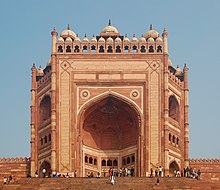
Architecture
Main articles: Indo-Islamic architecture, Mughal architecture, and Mughal gardenThe Mughals made a major contribution to the Indian subcontinent with the development of their unique Indo-Persian architecture. Many monuments were built during the Mughal era by the Muslim emperors, especially Shah Jahan, including the Taj Mahal—a UNESCO World Heritage Site considered "the jewel of Muslim art in India and one of the universally admired masterpieces of the world's heritage", attracting 7–8 million unique visitors a year. The palaces, tombs, gardens and forts built by the dynasty stand today in Agra, Aurangabad, Delhi, Dhaka, Fatehpur Sikri, Jaipur, Lahore, Kabul, Sheikhupura, and many other cities of India, Pakistan, Afghanistan, and Bangladesh, such as:
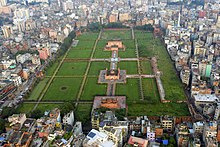
| India | Pakistan | Bangladesh | Afghanistan |
|---|---|---|---|
|
|
|
|
Art and literature
Main articles: Mughal painting and Mughal clothing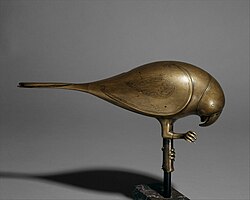
The Mughal artistic tradition, mainly expressed in painted miniatures, as well as small luxury objects, was eclectic, borrowing from Iranian, Indian, Chinese and Renaissance European stylistic and thematic elements. Mughal emperors often took in Iranian bookbinders, illustrators, painters and calligraphers from the Safavid court due to the commonalities of their Timurid styles, and due to the Mughal affinity for Iranian art and calligraphy. Miniatures commissioned by the Mughal emperors initially focused on large projects illustrating books with eventful historical scenes and court life, but later included more single images for albums, with portraits and animal paintings displaying a profound appreciation for the serenity and beauty of the natural world. For example, Emperor Jahangir commissioned brilliant artists such as Ustad Mansur to realistically portray unusual flora and fauna throughout the empire.
The literary works Akbar and Jahangir ordered to be illustrated ranged from epics like the Razmnama (a Persian translation of the Hindu epic, the Mahabharata) to historical memoirs or biographies of the dynasty such as the Baburnama and Akbarnama, and Tuzk-e-Jahangiri. Richly-finished albums (muraqqa) decorated with calligraphy and artistic scenes were mounted onto pages with decorative borders and then bound with covers of stamped and gilded or painted and lacquered leather. Aurangzeb (1658–1707) was never an enthusiastic patron of painting, largely for religious reasons, and took a turn away from the pomp and ceremonial of the court around 1668, after which he probably commissioned no more paintings.
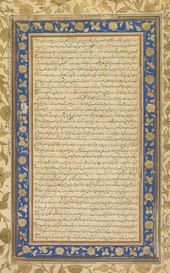
Language
Main articles: Persian language in the Indian subcontinent, Persian and Urdu, and Hindustani languageAccording to Qazvini, by the time of Shah Jahan, the emperor was only familiar with a few Turki words and showed little interest in the study of the language as a child. Though the Mughals were of Turko-Mongol origin, their reign enacted the revival and height of the Persian language in the Indian subcontinent. Accompanied by literary patronage was the institutionalisation of Persian as official and courtly language; this led to Persian reaching nearly the status of a first language for many inhabitants of Mughal India. Muzaffar Alam argues that the Mughals used Persian purposefully as the vehicle of an overarching Indo-Persian political culture, to unite their diverse empire. Persian had a profound impact on the languages of South Asia; one such language, today known as Urdu, developed in the imperial capital of Delhi in the late Mughal era. It began to be used as a literary language in the Mughal court from the reign of Shah Alam II, who described it as the language of his dastans (prose romances), and replaced Persian as the informal language of the Muslim elite. According to Mir Taqi Mir, "Urdu was the language of Hindustan by the authority of the King."
Military
Further information: Army of the Mughal Empire, Mughal weapons, and Mughal artilleryGunpowder warfare
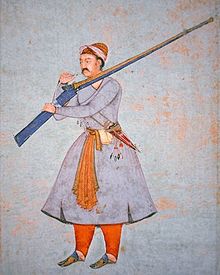
Mughal India was one of the three Islamic gunpowder empires, along with the Ottoman Empire and Safavid Persia. By the time he was invited by Lodi governor of Lahore, Daulat Khan, to support his rebellion against Lodi Sultan Ibrahim Khan, Babur was familiar with gunpowder firearms and field artillery, and a method for deploying them. Babur had employed Ottoman expert Ustad Ali Quli, who showed Babur the standard Ottoman formation—artillery and firearm-equipped infantry protected by wagons in the centre and the mounted archers on both wings. Babur used this formation at the First Battle of Panipat in 1526, where the Afghan and Rajput forces loyal to the Delhi Sultanate, though superior in numbers but without the gunpowder weapons, were defeated. The decisive victory of the Timurid forces is one reason opponents rarely met Mughal princes in pitched battle over the course of the empire's history. In India, guns made of bronze were recovered from Calicut (1504) and Diu (1533). Fathullah Shirazi (c. 1582), a Persian polymath and mechanical engineer who worked for Akbar, developed an early multi gun shot. As opposed to the polybolos and repeating crossbows used earlier in ancient Greece and China, respectively, Shirazi's rapid-firing gun had multiple gun barrels that fired hand cannons loaded with gunpowder. It may be considered a version of a volley gun.
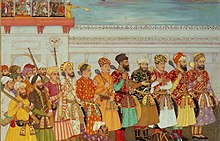
By the 17th century, Indians were manufacturing a diverse variety of firearms; large guns in particular, became visible in Tanjore, Dacca, Bijapur and Murshidabad.
Rocketry and explosives
See also: Mysorean rockets and Congreve rocketIn the sixteenth century, Akbar was the first to initiate and use metal cylinder rockets known as bans, particularly against war elephants, during the Battle of Sanbal. In 1657, the Mughal Army used rockets during the Siege of Bidar. Prince Aurangzeb's forces discharged rockets and grenades while scaling the walls. Sidi Marjan was mortally wounded when a rocket struck his large gunpowder depot, and after twenty-seven days of hard fighting Bidar was captured by the Mughals.
In A History of Greek Fire and Gunpowder, James Riddick Partington described Indian rockets and explosive mines:
The Indian war rockets ... were formidable weapons before such rockets were used in Europe. They had bam-boo rods, a rocket-body lashed to the rod, and iron points. They were directed at the target and fired by lighting the fuse, but the trajectory was rather erratic. The use of mines and counter-mines with explosive charges of gunpowder is mentioned for the times of Akbar and Jahangir.
Later, the Mysorean rockets were upgraded versions of Mughal rockets used during the Siege of Jinji by the progeny of the Nawab of Arcot. Hyder Ali's father Fatah Muhammad the constable at Budikote, commanded a corps consisting of 50 rocketmen (Cushoon) for the Nawab of Arcot. Hyder Ali realised the importance of rockets and introduced advanced versions of metal cylinder rockets. These rockets turned fortunes in favour of the Sultanate of Mysore during the Second Anglo-Mysore War, particularly during the Battle of Pollilur. In turn, the Mysorean rockets were the basis for the Congreve rockets, which Britain deployed in the Napoleonic Wars against France and the War of 1812 against the United States.
Science
Astronomy
See also: Astronomy in the medieval Islamic world and Indian astronomyWhile there appears to have been little concern for theoretical astronomy, Mughal astronomers made advances in observational astronomy and produced some Zij treatises. Humayun built a personal observatory near Delhi. According to Sulaiman Nadvi, Jahangir and Shah Jahan intended to build observatories too, but were unable to do so. The astronomical instruments and observational techniques used at the Mughal observatories were mainly derived from Islamic astronomy. In the 17th century, the Mughal Empire saw a synthesis between Islamic and Hindu astronomy, where Islamic observational instruments were combined with Hindu computational techniques.
During the decline of the Mughal Empire, the Hindu king Jai Singh II of Amber continued the work of Mughal astronomy. In the early 18th century, he built several large observatories called Yantra Mandirs, in order to rival Ulugh Beg's Samarkand observatory, and in order to improve on the earlier Hindu computations in the Siddhantas and Islamic observations in Zij-i-Sultani. The instruments he used were influenced by Islamic astronomy, while the computational techniques were derived from Hindu astronomy.
Chemistry
See also: Alchemy in the medieval Islamic worldSake Dean Mahomed had learned much of Mughal chemistry and understood the techniques used to produce various alkali and soaps to produce shampoo. He was also a notable writer who described the Mughal Emperor Shah Alam II and the cities of Allahabad and Delhi in rich detail and also made note of the glories of the Mughal Empire.
In Britain, Sake Dean Mahomed was appointed as shampooing surgeon to both Kings George IV and William IV.
Metallurgy
See also: History of metallurgy in the Indian subcontinentOne of the most remarkable astronomical instruments invented in Mughal India is the lost-wax cast, hollow, seamless, celestial globe. It was invented in Kashmir by Ali Kashmiri ibn Luqman in 998 AH (1589–90 CE), and twenty other such globes were later produced in Lahore and Kashmir during the Mughal Empire. Before they were rediscovered in the 1980s, it was believed by modern metallurgists to be technically impossible to produce hollow metal globes without any seams. A 17th century celestial globe was also made by Diya’ ad-din Muhammad in Lahore, 1668 (now in Pakistan). It is now housed at the National Museum of Scotland.
List of Mughal Emperors
Main article: Mughal emperors| Portrait | Titular Name | Birth Name | Birth | Reign | Death |
|---|---|---|---|---|---|
1 
|
Babur بابر |
Zahir al-Din Muhammad ظہیر الدین محمد |
14 February 1483 Andijan, Uzbekistan | 20 April 1526 – 26 December 1530 | 26 December 1530 (aged 47) Agra, India |
2 
|
Humayun ہمایوں |
Nasir al-Din Muhammad نصیر الدین محمد |
6 March 1508 Kabul, Afghanistan | 26 December 1530 – 17 May 1540
22 February 1555 – 27 January 1556 (10 years 3 months 25 days) |
27 January 1556 (aged 47) Delhi, India |
3 
|
Akbar the Great اکبر |
Jalal al-Din Muhammad جلال الدین محمد |
15 October 1542 Umerkot, Pakistan | 11 February 1556 – 27 October 1605
(49 years 9 months 0 days) |
27 October 1605 (aged 63) Agra, India |
4 
|
Jahangir جہانگیر |
Nur al-Din Muhammad نور الدین محمد |
31 August 1569 Agra, India | 3 November 1605 – 28 October 1627
(21 years 11 months 23 days) |
28 October 1627 (aged 58) Jammu and Kashmir, India |
5 
|
Shah Jahan شاہ جہان |
Shihab al-Din Muhammad شہاب الدین محمد |
5 January 1592 Lahore, Pakistan | 19 January 1628 – 31 July 1658
(30 years 8 months 25 days) |
22 January 1666 (aged 74) Agra, India |
6 
|
Aurangzeb اورنگزیب Alamgir |
Muhi al-Din Muhammad محی الدین محمد |
3 November 1618 Gujarat, India | 31 July 1658 – 3 March 1707
(48 years 7 months 0 days) |
3 March 1707 (aged 88) Ahmednagar, India |
7 
|
Azam Shah اعظم شاہ |
Qutb al-Din Muhammad قطب الدين محمد |
28 June 1653 Burhanpur, India | 14 March 1707 – 20 June 1707 | 20 June 1707 (aged 53) Agra, India |
8 
|
Bahadur Shah بہادر شاہ |
Qutb al-Din Muhammad قطب الدین محمد |
14 October 1643 Burhanpur, India | 19 June 1707 – 27 February 1712
(4 years, 253 days) |
27 February 1712 (aged 68) Lahore, Pakistan |
9 
|
Jahandar Shah جہاندار شاہ |
Muiz al-Din Muhammad معز الدین محمد |
9 May 1661 Deccan, India | 27 February 1712 – 11 February 1713
(0 years, 350 days) |
12 February 1713 (aged 51) Delhi, India |
10
|
Farrukh Siyar فرخ سیر |
Muin al-Din Muhammad موئن الدین محمد Puppet King Under the Sayyids of Barha |
20 August 1685 Aurangabad, India | 11 January 1713 – 28 February 1719
(6 years, 48 days) |
19 April 1719 (aged 33) Delhi, India |
11
|
Rafi ud-Darajat رفیع الدرجات |
Shams al-Din Muhammad شمس الدین محمد Puppet King Under the Sayyids of Barha |
1 December 1699 | 28 February 1719 – 6 June 1719
(0 years, 98 days) |
6 June 1719 (aged 19) Agra, India |
12
|
Shah Jahan II شاہ جہان دوم |
Rafi al-Din Muhammad رفع الدين محمد Puppet King Under the Sayyids of Barha |
5 January 1696 | 6 June 1719 – 17 September 1719
(0 years, 105 days) |
18 September 1719 (aged 23) Agra, India |
13
|
Muhammad Shah محمد شاہ |
Nasir al-Din Muhammad نصیر الدین محمد Puppet King Under the Sayyids of Barha |
7 August 1702 Ghazni, Afghanistan | 27 September 1719 – 26 April 1748
(28 years, 212 days) |
26 April 1748 (aged 45) Delhi, India |
14
|
Ahmad Shah Bahadur احمد شاہ بہادر |
Mujahid al-Din Muhammad مجاہد الدین محمد |
23 December 1725 Delhi, India | 29 April 1748 – 2 June 1754
(6 years, 37 days) |
1 January 1775 (aged 49) Delhi, India |
15
|
Alamgir II عالمگیر دوم |
Aziz al-Din Muhammad عزیز اُلدین محمد |
6 June 1699 Burhanpur, India | 3 June 1754 – 29 November 1759
(5 years, 180 days) |
29 November 1759 (aged 60) Kotla Fateh Shah, India |
16
|
Shah Jahan III شاہ جہان سوم |
Muhi al-Millat محی اُلملت |
1711 | 10 December 1759 – 10 October 1760
(282 days) |
1772 (aged 60–61) |
17
|
Shah Alam II شاہ عالم دوم |
Jalal al-Din Muhammad Ali Gauhar جلال الدین علی گوہر |
25 June 1728 Delhi, India | 10 October 1760 – 31 July 1788
(27 years, 301 days) |
19 November 1806 (aged 78) Delhi, India |
18
|
Shah Jahan IV جہان شاه چہارم |
Bidar Bakht Mahmud Shah Bahadur Jahan Shah بیدار بخت محمود شاه بهادر جہان شاہ |
1749 Delhi, India | 31 July 1788 – 11 October 1788
(63 days) |
1790 (aged 40–41) Delhi, India |
17
|
Shah Alam II شاہ عالم دوم |
Jalal al-Din Muhammad Ali Gauhar جلال الدین علی گوہر Puppet King under the Maratha Empire |
25 June 1728 Delhi, India | 16 October 1788 – 19 November 1806
(18 years, 339 days) |
19 November 1806 (aged 78) Delhi, India |
19
|
Akbar Shah II اکبر شاہ دوم |
Muin al-Din Muhammad میرزا اکبر Puppet King under the East India Company |
22 April 1760 Mukundpur, India | 19 November 1806 – 28 September 1837
(30 years, 321 days) |
28 September 1837 (aged 77) Delhi, India |
20
|
Bahadur Shah II Zafar بہادر شاہ ظفر |
Abu Zafar Siraj al-Din Muhammad ابو ظفر سراج اُلدین محمد |
24 October 1775 Delhi, India | 28 September 1837 – 21 September 1857
(19 years, 360 days) |
7 November 1862 (aged 87) Rangoon, Myanmar |
See also
- Mughal dynasty
- Flags of the Mughal Empire
- Mughal emperors
- List of Mongol states
- Mansabdar
- Mughal people
- Mughal Harem
- Mughal weapons
- Mughal architecture
- Mughlai cuisine
- Mughal-Mongol genealogy
- Islam in South Asia
- Siege of Orchha
References
Footnotes
- The title (Mirza) descends to all the sons of the family, without exception. In the royal family it is placed after the name instead of before it, thus, Abbas Mirza and Hosfiein Mirza. Mirza is a civil title, and Khan is a military one. The title of Khan is creative, but not hereditary.
Citations
- Sinopoli, Carla M. (1994). "Monumentality and Mobility in Mughal Capitals". Asian Perspectives. 33 (2): 294. ISSN 0066-8435. JSTOR 42928323. Archived from the original on 1 May 2022. Retrieved 11 June 2021.
- Conan 2007, p. 235.
- "Islam: Mughal Empire (1500s, 1600s)". BBC. 7 September 2009. Archived from the original on 13 August 2018. Retrieved 13 June 2019.
- Pagaza & Argyriades 2009, p. 129.
- Morier 1812, p. 601.
- Turchin, Peter; Adams, Jonathan M.; Hall, Thomas D. (2006). "East–West Orientation of Historical Empires and Modern States". Journal of World-Systems Research. 12 (2): 219–229. doi:10.5195/JWSR.2006.369. ISSN 1076-156X.
- Rein Taagepera (September 1997). "Expansion and Contraction Patterns of Large Polities: Context for Russia". International Studies Quarterly. 41 (3): 475–504. doi:10.1111/0020-8833.00053. JSTOR 2600793. Archived from the original on 19 November 2018. Retrieved 6 July 2019.
- Dyson, Tim (2018). A Population History of India: From the First Modern People to the Present Day. Oxford University Press. pp. 70–71. ISBN 978-0-19-256430-6.
We have seen that there is considerable uncertainty about the size of India's population c.1595. Serious assessments vary from 116 to 145 million (with an average of 125 million). However, the true figure could even be outside of this range. Accordingly, while it seems likely that the population grew over the course of the seventeenth century, it is unlikely that we will ever have a good idea of its size in 1707.
- ^ József Böröcz (2009). The European Union and Global Social Change. Routledge. p. 21. ISBN 978-1-135-25580-0. Retrieved 26 June 2017.
- ^ Richards, John F. (1995). The Mughal Empire. Cambridge University Press. ISBN 978-0-521-56603-2.
- Richards, John F. (1995), The Mughal Empire, Cambridge University Press, p. 2, ISBN 978-0-521-56603-2, archived from the original on 22 September 2023, retrieved 9 August 2017 Quote: "Although the first two Timurid emperors and many of their noblemen were recent migrants to the subcontinent, the dynasty and the empire itself became indisputably Indian. The interests and futures of all concerned were in India, not in ancestral homelands in the Middle East or Central Asia. Furthermore, the Mughal Empire emerged from the Indian historical experience. It was the end product of a millennium of Muslim conquest, colonization, and state-building in the Indian subcontinent."
- Stein, Burton (2010), A History of India, John Wiley & Sons, pp. 159–, ISBN 978-1-4443-2351-1, archived from the original on 22 September 2023, retrieved 15 July 2019 Quote: "The realm so defined and governed was a vast territory of some 750,000 square miles , ranging from the frontier with Central Asia in northern Afghanistan to the northern uplands of the Deccan plateau, and from the Indus basin on the west to the Assamese highlands in the east."
- Gilbert, Marc Jason (2017), South Asia in World History, Oxford University Press, p. 62, ISBN 978-0-19-066137-3, retrieved 15 July 2019 Quote: "Babur then adroitly gave the Ottomans his promise not to attack them in return for their military aid, which he received in the form of the newest of battlefield inventions, the matchlock gun and cast cannons, as well as instructors to train his men to use them."
- Stein, Burton (2010), A History of India, John Wiley & Sons, pp. 159–, ISBN 978-1-4443-2351-1, archived from the original on 22 September 2023, retrieved 15 July 2019 Quote: "Another possible date for the beginning of the Mughal regime is 1600, when the institutions that defined the regime were set firmly in place and when the heartland of the empire was defined; both of these were the accomplishment of Babur's grandson Akbar."
- Stein, Burton (2010), A History of India, John Wiley & Sons, pp. 159–, ISBN 978-1-4443-2351-1, archived from the original on 22 September 2023, retrieved 15 July 2019 Quote: "The imperial career of the Mughal house is conventionally reckoned to have ended in 1707 when the emperor Aurangzeb, a fifth-generation descendant of Babur, died. His fifty-year reign began in 1658 with the Mughal state seeming as strong as ever or even stronger. But in Aurangzeb's later years the state was brought to the brink of destruction, over which it toppled within a decade and a half after his death; by 1720 imperial Mughal rule was largely finished and an epoch of two imperial centuries had closed."
- Richards, John F. (1995), The Mughal Empire, Cambridge University Press, p. xv, ISBN 978-0-521-56603-2, archived from the original on 22 September 2023, retrieved 1 July 2019 Quote: "By the latter date (1720) the essential structure of the centralized state was disintegrated beyond repair."
- Stein, Burton (2010), A History of India, John Wiley & Sons, pp. 159–, ISBN 978-1-4443-2351-1, archived from the original on 22 September 2023, retrieved 15 July 2019 Quote: "The vaunting of such progenitors pointed up the central character of the Mughal regime as a warrior state: it was born in war and it was sustained by war until the eighteenth century, when warfare destroyed it."
- Robb, Peter (2011), A History of India, Macmillan, pp. 108–, ISBN 978-0-230-34549-2 Quote: "The Mughal state was geared for war, and succeeded while it won its battles. It controlled territory partly through its network of strongholds, from its fortified capitals in Agra, Delhi or Lahore, which defined its heartlands, to the converted and expanded forts of Rajasthan and the Deccan. The emperors' will was frequently enforced in battle. Hundreds of army scouts were an important source of information. But the empire's administrative structure too was defined by and directed at war. Local military checkpoints or thanas kept order. Directly appointed imperial military and civil commanders (faujdars) controlled the cavalry and infantry, or the administration, in each region. The peasantry in turn were often armed, able to provide supporters for regional powers, and liable to rebellion on their own account: continual pacification was required of the rulers."
- Gilbert, Marc Jason (2017), South Asia in World History, Oxford University Press, pp. 75–, ISBN 978-0-19-066137-3, archived from the original on 22 September 2023, retrieved 15 July 2019 Quote: "With Safavid and Ottoman aid, the Mughals would soon join these two powers in a triumvirate of warrior-driven, expansionist, and both militarily and bureaucratically efficient early modern states, now often called "gunpowder empires" due to their common proficiency is using such weapons to conquer lands they sought to control."
- Asher, Catherine B.; Talbot, Cynthia (2006), India Before Europe, Cambridge University Press, pp. 115–, ISBN 978-0-521-80904-7, archived from the original on 22 September 2023, retrieved 15 July 2019
- Robb, Peter (2011). A History of India. Macmillan. pp. 99–100. ISBN 978-0-230-34549-2.
- ^ Asher, Catherine B.; Talbot, Cynthia (2006), India Before Europe, Cambridge University Press, pp. 152–, ISBN 978-0-521-80904-7, archived from the original on 22 September 2023, retrieved 15 July 2019
- ^ Stein, Burton (2010), A History of India, John Wiley & Sons, pp. 164–, ISBN 978-1-4443-2351-1, archived from the original on 22 September 2023, retrieved 15 July 2019 Quote: "The resource base of Akbar's new order was land revenue"
- ^ Asher, Catherine B.; Talbot, Cynthia (2006), India Before Europe, Cambridge University Press, pp. 158–, ISBN 978-0-521-80904-7, archived from the original on 22 September 2023, retrieved 15 July 2019 Quote: "The Mughal empire was based in the interior of a large land-mass and derived the vast majority of its revenues from agriculture."
- ^ Stein, Burton (2010), A History of India, John Wiley & Sons, pp. 164–, ISBN 978-1-4443-2351-1, archived from the original on 22 September 2023, retrieved 15 July 2019 Quote: "... well over half of the output from the fields in his realm, after the costs of production had been met, is estimated to have been taken from the peasant producers by way of official taxes and unofficial exactions. Moreover, payments were exacted in money, and this required a well regulated silver currency."
- ^ Asher, Catherine B.; Talbot, Cynthia (2006), India Before Europe, Cambridge University Press, pp. 152–, ISBN 978-0-521-80904-7, archived from the original on 22 September 2023, retrieved 15 July 2019 Quote: "His stipulation that land taxes be paid in cash forced peasants into market networks, where they could obtain the necessary money, while the standardization of imperial currency made the exchange of goods for money easier."
- Asher, Catherine B.; Talbot, Cynthia (2006), India Before Europe, Cambridge University Press, pp. 152–, ISBN 978-0-521-80904-7, archived from the original on 22 September 2023, retrieved 15 July 2019 Quote: "Above all, the long period of relative peace ushered in by Akbar's power, and maintained by his successors, contributed to India's economic expansion."
- Asher, Catherine B.; Talbot, Cynthia (2006), India Before Europe, Cambridge University Press, pp. 186–, ISBN 978-0-521-80904-7, archived from the original on 22 September 2023, retrieved 15 July 2019 Quote: "As the European presence in India grew, their demands for Indian goods and trading rights increased, thus bringing even greater wealth to the already flush Indian courts."
- Asher, Catherine B.; Talbot, Cynthia (2006), India Before Europe, Cambridge University Press, pp. 186–, ISBN 978-0-521-80904-7, archived from the original on 22 September 2023, retrieved 15 July 2019 Quote: "The elite spent more and more money on luxury goods, and sumptuous lifestyles, and the rulers built entire new capital cities at times."
- Asher, Catherine B.; Talbot, Cynthia (2006), India Before Europe, Cambridge University Press, pp. 186–, ISBN 978-0-521-80904-7, archived from the original on 22 September 2023, retrieved 15 July 2019 Quote: "All these factors resulted in greater patronage of the arts, including textiles, paintings, architecture, jewelry, and weapons to meet the ceremonial requirements of kings and princes."
- ^ Centre, UNESCO World Heritage. "Taj Mahal". UNESCO World Heritage Centre. Archived from the original on 1 February 2018. Retrieved 7 May 2020.
- Vanina, Eugenia (2012). Medieval Indian Mindscapes: Space, Time, Society, Man. Primus Books. p. 47. ISBN 978-93-80607-19-1. Archived from the original on 22 September 2023. Retrieved 19 October 2015.
- Nehemia Levtzion (1979). Conversion to Islam. Holmes & Meier. ISBN 978-0-8419-0343-2. Archived from the original on 3 April 2023. Retrieved 19 March 2023.
- "Name of the Monument/ site: Tomb of Aurangzeb" (PDF). asiaurangabad.in. Archived from the original (PDF) on 23 September 2015.
- Mosca, Matthew (20 February 2013). From Frontier Policy to Foreign Policy: The Question of India and the Transformation of Geopolitics in Qing China. Stanford University Press. pp. 79–94. ISBN 978-0-8047-8538-9.
- Fontana, Michela (2011). Matteo Ricci: A Jesuit in the Ming Court. Rowman & Littlefield Publishers. p. 32. ISBN 978-1-4422-0588-8. Archived from the original on 22 September 2023. Retrieved 19 October 2015.
- Zahir ud-Din Mohammad (2002). Thackston, Wheeler M. (ed.). The Baburnama: Memoirs of Babur, Prince and Emperor. New York: Modern Library. p. xlvi. ISBN 978-0-375-76137-9.
In India the dynasty always called itself Gurkani, after Temür's title Gurkân, the Persianized form of the Mongolian kürägän, 'son-in-law,' a title he assumed after his marriage to a Genghisid princess.
- ^ Dodgson, Marshall G.S. (2009). The Venture of Islam. Vol. 3. University of Chicago Press. p. 62. ISBN 978-0-226-34688-5.
- Huskin, Frans Husken; Dick van der Meij (2004). Reading Asia: New Research in Asian Studies. Routledge. p. 104. ISBN 978-1-136-84377-8.
- John Walbridge. God and Logic in Islam: The Caliphate of Reason. p. 165.
Persianate Mogul Empire.
- Rutherford 2010.
- Canfield, Robert L. (2002). Turko-Persia in Historical Perspective. Cambridge University Press. p. 20. ISBN 978-0-521-52291-5.
- ^ Berndl, Klaus (2005). National Geographic Visual History of the World. National Geographic Society. pp. 318–320. ISBN 978-0-7922-3695-5.
- Gérard Chaliand, A Global History of War: From Assyria to the Twenty-First Century, University of California Press, California 2014, p. 151
- Bayley, Christopher. The European Emergence. The Mughals Ascendant. p. 151. ISBN 0-7054-0982-1.
- Hooja, Rima (2006). A History of Rajasthan. Rupa. p. 454. ISBN 978-81-291-1501-0. Archived from the original on 22 September 2023. Retrieved 16 June 2022.
From Baburs memoirs we learn that Sanga's success against the Mughal advance guard commanded by Abdul Aziz and other forces at Bayana, severely demoralised the fighting spirit of Baburs troops encamped near Sikri.
- Bayley, Christopher. The European Emergence. The Mughals Ascendant. p. 154. ISBN 0-7054-0982-1.
- Ballhatchet, Kenneth A. "Akbar". Encyclopædia Britannica. Archived from the original on 25 May 2023. Retrieved 17 July 2017.
- Smith, Vincent Arthur (1917). Akbar the Great Mogul, 1542–1605. Oxford at The Clarendon Press. pp. 13–14.
- Begum, Gulbadan (1902). The History of Humāyūn (Humāyūn-Nāma). Translated by Beveridge, Annette S. Royal Asiatic Society. pp. 237–239.
- ^ Mohammada, Malika (2007). The Foundations of the Composite Culture in India. Aakar Books. p. 300. ISBN 978-81-89833-18-3.
- Gilbert, Marc Jason (2017). South Asia in World History. Oxford University Press. p. 79. ISBN 978-0-19-976034-3. Archived from the original on 22 September 2023. Retrieved 22 August 2017.
- Muhammad-Hadi (1999). Preface to The Jahangirnama. Translated by Thackston, Wheeler M. Oxford University Press. p. 4. ISBN 978-0-19-512718-8.
- Jahangir, Emperor of Hindustan (1999). The Jahangirnama: Memoirs of Jahangir, Emperor of India. Translated by Thackston, Wheeler M. Oxford University Press. p. 65. ISBN 978-0-19-512718-8.
- Faruqui, Munis D. (2012). The Princes of the Mughal Empire, 1504–1719. Cambridge University Press. pp. 268–269. ISBN 978-1-107-02217-1.
- Robb, Peter (2011), A History of India, Macmillan International Higher Education, pp. 97–98, ISBN 978-0-230-34424-2
- ^ Asher, Catherine B.; Talbot, Cynthia (2006). India before Europe. Cambridge University Press. p. 267. ISBN 0-521-80904-5. OCLC 61303480.
- ^ "BBC – Religions – Sikhism: Origins of Sikhism". BBC. 30 September 2009. Archived from the original on 17 August 2018. Retrieved 19 February 2021.
- Mehta, Jaswant Lal (1984) . Advanced Study in the History of Medieval India. Vol. II (2nd ed.). Sterling Publishers Pvt. Ltd. p. 59. ISBN 978-81-207-1015-3. OCLC 1008395679.
- Singhal, Damodar P. (1983). A History of the Indian People. Methuen. p. 193. ISBN 978-0-413-48730-8. Archived from the original on 22 September 2023. Retrieved 4 May 2021.
- Dara Shikoh Archived 3 April 2023 at the Wayback Machine Medieval Islamic Civilization: An Encyclopedia, by Josef W. Meri, Jere L Bacharach. Routledge, 2005. ISBN 0-415-96690-6. Page 195-196.
- ^ Truschke, Audrey (2017). Aurangzeb: The Life and Legacy of India's Most Controversial King. Stanford University Press. ISBN 978-1-5036-0259-5.
- Robb, Peter (2011). A History of India. Macmillan International Higher Education. p. 98. ISBN 978-0-230-34424-2.
- Abhishek Kaicker (2020). The King and the People: Sovereignty and Popular Politics in Mughal Delhi. Oxford University Press. ISBN 978-0-19-007067-0. Archived from the original on 3 April 2023. Retrieved 19 March 2023.
- Sarkar Jadunath (1928). A Short History Of Aurangzib.
- White, Matthew (2011). Atrocitology: Humanity's 100 Deadliest Achievements. Canongate Books. p. 113. ISBN 978-0-85786-125-2. Archived from the original on 22 September 2023. Retrieved 19 May 2023.
- Mikaberidze, Alexander (2011). Conflict and Conquest in the Islamic World: A Historical Encyclopedia [2 volumes]: A Historical Encyclopedia. ABC-CLIO. p. 43. ISBN 978-1-59884-337-8.
- Copland, Ian; Mabbett, Ian; Roy, Asim; et al. (2013). A History of State and Religion in India. Routledge. p. 119. ISBN 978-1-136-45950-4.
- Verghese, Ajay; Foa, Roberto Stefan (5 November 2018). "Precolonial Ethnic Violence:The Case of Hindu-Muslim Conflict in India" (PDF). Boston University. Archived (PDF) from the original on 7 April 2023. Retrieved 7 April 2023.
- Audrey Truschke (2021). the Language of History:Sanskrit Narratives of Indo-Muslim Rule. Publisher:Columbia University Press. ISBN 978-0-231-55195-3. Archived from the original on 3 April 2023. Retrieved 19 March 2023.
- Muhammad Yasin (1958). A Social History of Islamic India, 1605–1748. Upper India Publishing House. p. 18. Archived from the original on 3 April 2023. Retrieved 27 March 2023.
became virtual rulers and 'de facto' sovereigns when they began to make and unmake emperors. They had developed a sort of common brotherhood among themselves
- Columbia University Press (2000). Columbia Chronologies of Asian History and Culture. Columbia University Press. p. 285. ISBN 978-0-231-11004-4. Archived from the original on 3 April 2023. Retrieved 19 March 2023.
- Richard M. Eaton (2013). Expanding Frontiers in South Asian and World History Essays in Honour of John F. Richards. Cambridge University Press. p. 21.
I consider all this army (Marathas) as my own and I will get my work done through them. It is necessary to take our hands off Malwa. God willing, I will enter into an understanding with them and entrust the Mulukgiri(raiding) on that side of the Narmada to them.
- Pagadi, Setu Madhavarao (1970). "Maratha-Nizam Relations : Nizam-Ul-Mulk's Letters". Annals of the Bhandarkar Oriental Research Institute. 51 (1/4): 94.
The Mughal court was hostile to Nizam-ul-Mulk. If it had the power, it would have crushed him. To save himself from the hostile intentions of the Emperor, the Nizam did not interfere with the Maratha activities in Malwa and Gujarat. As revealed in the anecdotes narrated by Lala Mansaram, Nizam-ul-Mulk considered the Maratha army operating in Malwa and Gujarat as his own.
- ^ Bose, Sugata; Jalal, Ayesha (2004). Modern South Asia: History, Culture, Political Economy (2nd ed.). Routledge. p. 41. ISBN 978-0-203-71253-5.
- Rathod, N.G. (1994). The Great Maratha Mahadaji Scindia. New Delhi: Sarup & Sons. p. 8. ISBN 978-81-85431-52-9.
- ^ Conermann, Stephan (4 August 2015), "Mughal Empire", Encyclopedia of Early Modern History Online, Brill, doi:10.1163/2352-0272_emho_com_024206, archived from the original on 26 March 2022, retrieved 28 March 2022
- Dalrymple, William (2007). The Last Mughal. Penguin Books. ISBN 978-0-14-310243-4.
- Richards, J.F. (1981). "Mughal State Finance and the Premodern World Economy". Comparative Studies in Society and History. 23 (2): 285–308. doi:10.1017/s0010417500013311. JSTOR 178737. S2CID 154809724.
- Sir William Wilson Hunter (1908). Imperial gazetteer of India. Clarendon Press. p. 107.
- Habib, Irfan (March 1969). "Potentialities of Capitalistic Development in the Economy of Mughal India". Journal of Economic History. 29 (1): 32–78. doi:10.1017/s0022050700097825. JSTOR 2115498. S2CID 91170802.
- Leonard, Karen (April 1979). "The 'Great Firm' Theory of the Decline of the Mughal Empire". Comparative Studies in Society and History. 21 (2): 151–167. doi:10.1017/s0010417500012792. JSTOR 178414. S2CID 54775994. Archived from the original on 21 December 2019. Retrieved 6 July 2019.
- Hallissey, Robert C. (1977). The Rajput Rebellion Against Aurangzeb. University of Missouri Press. pp. ix, x, 84. ISBN 978-0-8262-0222-2.
- Claude Markovits (2004) . A History of Modern India, 1480–1950. Anthem Press. pp. 172–173. ISBN 978-1-84331-004-4.
- ^ Jeffrey G. Williamson, David Clingingsmith (August 2005). "India's Deindustrialization in the 18th and 19th Centuries" (PDF). Harvard University. Archived (PDF) from the original on 13 December 2016. Retrieved 18 May 2017.
- ^ Jeffrey G. Williamson (2011). Trade and Poverty: When the Third World Fell Behind. MIT Press. p. 91. ISBN 978-0-262-29518-5. Archived from the original on 22 September 2023. Retrieved 15 August 2017.
- Broadberry, Stephen; Gupta, Bishnupriya (2005). Cotton textiles and the great divergence: Lancashire, India and shifting competitive advantage, 1600–1850 (PDF). The Rise, Organization, and Institutional Framework of Factor Markets. Utrecht University. Archived (PDF) from the original on 10 September 2016. Retrieved 5 December 2016.
- ^ Robinson, Francis (2009), "Mughal Empire", The Oxford Encyclopedia of the Islamic World, Oxford University Press, doi:10.1093/acref/9780195305135.001.0001, ISBN 978-0-19-530513-5, archived from the original on 29 March 2022, retrieved 28 March 2022
- Burton-Page, J.; Islam, Riazul; Athar Ali, M.; Moosvi, Shireen; Moreland, W. H.; Bosworth, C. E.; Schimmel, Annemarie; Koch, Ebba; Hall, Margaret (24 April 2012), "Mug̲h̲als", Encyclopaedia of Islam, Second Edition, Brill, doi:10.1163/1573-3912_islam_com_0778, archived from the original on 31 March 2022, retrieved 31 March 2022
- Gladden, E.N. A History of Public Administration Volume II: From the Eleventh Century to the Present Day. Routledge. pp. 234–236. ISBN 978-0-429-42321-5.
- Michael, Bernardo A. (2012). Statemaking and Territory in South Asia. Anthem Press. p. 67. doi:10.7135/upo9780857285324.005. ISBN 978-0-85728-532-4.
- Michael, Bernardo A. (2012). Statemaking and Territory in South Asia. Anthem Press. p. 69, 75, 77-78. doi:10.7135/upo9780857285324.005. ISBN 978-0-85728-532-4.
- ^ Sinopoli, Carla M. (1994). "Monumentality and Mobility in Mughal Capitals". Asian Perspectives. 33 (2): 294–295. ISSN 0066-8435. JSTOR 42928323. Archived from the original on 1 May 2022. Retrieved 11 June 2021.
- Sinopoli, Carla M. (1994). "Monumentality and Mobility in Mughal Capitals". Asian Perspectives. 33 (2): 304–305. ISSN 0066-8435. JSTOR 42928323. Archived from the original on 1 May 2022. Retrieved 11 June 2021.
- Samrin, Farah (2005). "The City of Kabul Under the Mughals". Proceedings of the Indian History Congress. 66: 1307. JSTOR 44145943. Archived from the original on 29 June 2021. Retrieved 14 December 2021.
- Sinopoli, Carla M. (1994). "Monumentality and Mobility in Mughal Capitals". Asian Perspectives. 33 (2): 296 & 298. ISSN 0066-8435. JSTOR 42928323. Archived from the original on 1 May 2022. Retrieved 11 June 2021.
- Bosworth, Clifford Edmund (2008). Historic cities of the Islamic world. Brill. p. 127. ISBN 978-90-04-15388-2. OCLC 231801473.
- ^ Chatterjee, Nandini (1 December 2019), "Courts of law, Mughal", Encyclopaedia of Islam, THREE, Brill, doi:10.1163/1573-3912_ei3_com_25171, archived from the original on 13 December 2021, retrieved 13 December 2021
- ^ Khalfaoui, Mouez. "Mughal Empire and Law". Oxford Islamic Studies Online. Archived from the original on 13 December 2021. Retrieved 13 December 2021.
- Conermann, Stephan (4 August 2015), "Mughal Empire", Encyclopedia of Early Modern History Online, Brill, doi:10.1163/2352-0272_emho_com_024206, archived from the original on 26 March 2022, retrieved 25 March 2022
- Chatterjee, Nandini (2014). "Reflections on Religious Difference and Permissive Inclusion in Mughal Law". Journal of Law and Religion. 29 (3): 396–415. doi:10.1017/jlr.2014.20. hdl:10871/15975. ISSN 0748-0814. S2CID 143513602. Archived from the original on 22 September 2023. Retrieved 13 December 2021.
- Eaton, Richard M. (2019). India in the Persianate Age : 1000–1765. University of California Press. p. 272. ISBN 978-0-520-97423-4. OCLC 1243310832.
- Schmidt, Karl J. (2015). An Atlas and Survey of South Asian History. Routledge. ISBN 978-1-317-47681-8.
- ^ Schmidt, Karl J. (2015). An Atlas and Survey of South Asian History. Routledge. pp. 100–. ISBN 978-1-317-47681-8. Archived from the original on 22 September 2023. Retrieved 9 August 2017.
- ^ Maddison, Angus (2003). Development Centre Studies The World Economy Historical Statistics: Historical Statistics. OECD Publishing. pp. 256–. ISBN 978-92-64-10414-3. Archived from the original on 20 January 2023. Retrieved 9 August 2017.
- Jeffrey G. Williamson & David Clingingsmith, India's Deindustrialization in the 18th and 19th Centuries Archived 29 March 2017 at the Wayback Machine, Global Economic History Network, London School of Economics
- ^ Roy, Tirthankar (2010). "The Long Globalization and Textile Producers in India". In Lex Heerma van Voss; Els Hiemstra-Kuperus; Elise van Nederveen Meerkerk (eds.). The Ashgate Companion to the History of Textile Workers, 1650–2000. Ashgate Publishing. p. 255. ISBN 978-0-7546-6428-4. Archived from the original on 2 July 2023. Retrieved 15 August 2017.
- "Picture of original Mughal rupiya introduced by Sher Shah Suri". Archived from the original on 5 October 2002. Retrieved 4 August 2017.
- Irfan Habib; Dharma Kumar; Tapan Raychaudhuri (1987). The Cambridge Economic History of India (PDF). Vol. 1. Cambridge University Press. p. 464. Archived (PDF) from the original on 4 August 2017. Retrieved 11 August 2017.
- ^ Richards, John F. (2003). The Unending Frontier: An Environmental History of the Early Modern World. University of California Press. pp. 27–. ISBN 978-0-520-93935-6. Archived from the original on 22 September 2023. Retrieved 9 August 2017.
- Tracy, James D. (1997). The Political Economy of Merchant Empires: State Power and World Trade, 1350–1750. Cambridge University Press. pp. 97–. ISBN 978-0-521-57464-8. Archived from the original on 22 September 2023. Retrieved 9 August 2017.
- Moosvi 2015, p. 433.
- Maddison, Angus (1971). Class Structure and Economic Growth: India and Pakistan Since the Moghuls. Taylor & Francis. p. 33. ISBN 978-0-415-38259-5. Archived from the original on 22 September 2023. Retrieved 22 August 2017.
- Broadberry, Stephen; Gupta, Bishnupriya (2003). "The Early Modern Great Divergence: Wages, Prices and Economic Development in Europe and Asia 1500–1800" (PDF). p. 34. Archived (PDF) from the original on 24 May 2022. Retrieved 22 January 2021.
- Parthasarathi, Prasannan (2011). Why Europe Grew Rich and Asia Did Not: Global Economic Divergence, 1600–1850. p. 42.
- Parthasarathi, Prasannan (2011). Why Europe Grew Rich and Asia Did Not: Global Economic Divergence, 1600–1850. p. 39.
- Sivramkrishna, Sashi (2009). "Ascertaining Living Standards in Erstwhile Mysore, Southern India, from Francis Buchanan's Journey of 1800–01: An Empirical Contribution to the Great Divergence". Journal of the Economic and Social History. 52 (4): 726. Archived from the original on 2 May 2022. Retrieved 22 January 2021.
- Sivramkrishna, Sashi (2009). "Ascertaining Living Standards in Erstwhile Mysore, Southern India, from Francis Buchanan's Journey of 1800–01: An Empirical Contribution to the Great Divergence". Journal of the Economic and Social History. 52 (4): 731. Archived from the original on 2 May 2022. Retrieved 22 January 2021.
- Parthasarathi, Prasannan (2011). Why Europe Grew Rich and Asia Did Not: Global Economic Divergence, 1600–1850. p. 45.
- Sivramkrishna, Sashi (2009). "Ascertaining Living Standards in Erstwhile Mysore, Southern India, from Francis Buchanan's Journey of 1800–01: An Empirical Contribution to the Great Divergence". Journal of the Economic and Social History. 52 (4): 729. Archived from the original on 2 May 2022. Retrieved 22 January 2021.
- Moosvi 2015, p. 432.
- Moosvi 2015, p. 450.
- ^ Moosvi, Shireen (December 2011). "The World of Labour in Mughal India (c. 1500–1750)". International Review of Social History. 56 (S19): 245–261. doi:10.1017/S0020859011000526.
- Pagaza, Ignacio; Argyriades, Demetrios (2009). Winning the Needed Change: Saving Our Planet Earth. IOS Press. p. 129. ISBN 978-1-58603-958-5.
- ^ Ludden, David (1999). An Agrarian History of South Asia. Cambridge University Press. p. 96. ISBN 978-0-521-36424-9. Archived from the original on 22 September 2023. Retrieved 29 April 2019.
- Irfan Habib; Dharma Kumar; Tapan Raychaudhuri (1987). The Cambridge Economic History of India (PDF). Vol. 1. Cambridge University Press. p. 214. Archived (PDF) from the original on 4 August 2017. Retrieved 5 August 2017.
- Irfan Habib; Dharma Kumar; Tapan Raychaudhuri (1987). The Cambridge Economic History of India (PDF). Vol. 1. Cambridge University Press. p. 217. Archived (PDF) from the original on 4 August 2017. Retrieved 5 August 2017.
- ^ Irfan Habib (2011), Economic History of Medieval India, 1200–1500, p. 53 Archived 22 September 2023 at the Wayback Machine, Pearson Education
- Suneja, Vivek (2000). Understanding Business: A Multidimensional Approach to the Market Economy. Psychology Press. p. 13. ISBN 978-0-415-23857-1. Archived from the original on 22 September 2023. Retrieved 9 August 2017.
- Parthasarathi, Prasannan (2011), Why Europe Grew Rich and Asia Did Not: Global Economic Divergence, 1600–1850, Cambridge University Press, pp. 39–45, ISBN 978-1-139-49889-0, archived from the original on 4 April 2023, retrieved 9 August 2017
- ^ Om Prakash, "Empire, Mughal Archived 18 November 2022 at the Wayback Machine", History of World Trade Since 1450, edited by John J. McCusker, vol. 1, Macmillan Reference US, 2006, pp. 237–240, World History in Context. Retrieved 3 August 2017
- Angus Maddison (1995), Monitoring the World Economy, 1820–1992, OECD, p. 30
- Parthasarathi, Prasannan (2011), Why Europe Grew Rich and Asia Did Not: Global Economic Divergence, 1600–1850, Cambridge University Press, p. 2, ISBN 978-1-139-49889-0
- ^ Richard Maxwell Eaton (1996), The Rise of Islam and the Bengal Frontier, 1204–1760, p. 202 Archived 4 April 2023 at the Wayback Machine, University of California Press
- Lakwete, Angela (2003). Inventing the Cotton Gin: Machine and Myth in Antebellum America. Baltimore: The Johns Hopkins University Press. pp. 1–6. ISBN 978-0-8018-7394-2. Archived from the original on 22 September 2023. Retrieved 3 August 2017.
- Irfan Habib (2011), Economic History of Medieval India, 1200–1500, pp. 53–54 Archived 22 September 2023 at the Wayback Machine, Pearson Education
- Irfan Habib (2011), Economic History of Medieval India, 1200–1500, p. 54 Archived 22 September 2023 at the Wayback Machine, Pearson Education
- دكتور محمد نصر. Fashion And Designing Under The Mughals Akbar To Aurangzeb. A Historical Perspective.
- Roy, Tirthankar (November 2011). "Where is Bengal? Situating an Indian Region in the Early Modern World Economy". Past & Present. 213 (1): 115–146. doi:10.1093/pastj/gtr009.
- Bayly, C. A. (1988). Indian Society and the Making of the British Empire. The New Cambridge History of India. Vol. II.1. Cambridge University Press. p. 51. ISBN 978-0-521-38650-0. Archived from the original on 8 February 2023. Retrieved 8 February 2023.
- "The paradise of nations". Dhaka Tribune. Archived from the original on 3 June 2016. Retrieved 30 April 2016.
- Daniyal, Shoaib. "Bengali New Year: how Akbar invented the modern Bengali calendar". Scroll.in. Archived from the original on 26 April 2022. Retrieved 30 April 2016.
- ^ Nanda, J. N. (2005). Bengal: The Unique State. Concept Publishing Company. p. 10. ISBN 978-81-8069-149-2. Archived from the original on 22 September 2023. Retrieved 5 May 2016.
- ^ Ray, Indrajit (2011). Bengal Industries and the British Industrial Revolution (1757–1857). Routledge. p. 174. ISBN 978-1-136-82552-1.
- "Technological Dynamism in a Stagnant Sector: Safety at Sea during the Early Industrial Revolution" (PDF). Archived (PDF) from the original on 11 December 2019. Retrieved 3 August 2017.
- ^ Colin McEvedy; Richard Jones (1978). Atlas of World Population History (PDF). New York: Facts on File. pp. 184–185. Archived (PDF) from the original on 12 November 2020. Retrieved 7 August 2017.
- Angus Maddison (2001), The World Economy: A Millennial Perspective, p. 236 Archived 11 November 2020 at the Wayback Machine, OECD Development Centre
- ^ Irfan Habib; Dharma Kumar; Tapan Raychaudhuri (1987). The Cambridge Economic History of India (PDF). Vol. 1. Cambridge University Press. p. 170. Archived (PDF) from the original on 4 August 2017. Retrieved 4 August 2017.
- ^ Jean-Noël Biraben, 1980, "An Essay Concerning Mankind's Evolution", Population, Selected Papers, Vol. 4, pp. 1–13
- ^ Eraly, Abraham (2007). The Mughal World: Life in India's Last Golden Age. Penguin Books India. pp. 5–. ISBN 978-0-14-310262-5.
- Paolo Malanima (2009). Pre-Modern European Economy: One Thousand Years (10th–19th Centuries). Brill Publishers. p. 244. ISBN 978-90-04-17822-9.
- Irfan Habib; Dharma Kumar; Tapan Raychaudhuri (1987). The Cambridge Economic History of India (PDF). Vol. 1. Cambridge University Press. p. 165. Archived (PDF) from the original on 4 August 2017. Retrieved 4 August 2017.
- Broadberry, Stephen; Gupta, Bishnupriya (2010). "Indian GDP before 1870: Some preliminary estimates and a comparison with Britain" (PDF). Warwick University. p. 23. Archived from the original (PDF) on 11 November 2020. Retrieved 12 October 2015.
- Dyson, Tim (2018). A Population History of India: From the First Modern People to the Present Day. pp. 63–65.
- Irfan Habib; Dharma Kumar; Tapan Raychaudhuri (1987). The Cambridge Economic History of India (PDF). Vol. 1. Cambridge University Press. p. 171. Archived (PDF) from the original on 4 August 2017. Retrieved 4 August 2017.
- Social Science Review, Volume 14, Issue 1, p. 126, Dhaka University
- Moosvi, Shireen (2008). People, Taxation, and Trade in Mughal India. Oxford University Press. p. 131. ISBN 978-0-19-569315-7.
- Chaudhuri, K. N. (2008). "Some Reflections on the Town and Country in Mughal India". Modern Asian Studies. 12 (1): 77–96. doi:10.1017/S0026749X00008155. ISSN 0026-749X. S2CID 146558617.
- Faruqi, Shamsur Rahman (2003). "A Long History of Urdu Literary Culture, Part 1". In Pollock, Sheldon (ed.). Literary Cultures in History. University of California Press. p. 806. ISBN 0-520-22821-9.
- Mughal Empire – MSN Encarta. Archived from the original on 28 October 2009.
- "Indo-Persian Literature Conference: SOAS: North Indian Literary Culture (1450–1650)". SOAS. Archived from the original on 23 September 2009. Retrieved 28 November 2012.
- "Islam: Mughal Empire (1500s, 1600s)". Religions. BBC. Archived from the original on 13 August 2018. Retrieved 10 June 2018.
- Fatma, Sadaf (2012). "Waterworks in Mughal Gardens". Proceedings of the Indian History Congress. 73: 1268–1278. JSTOR 44156328.
- Alter, Joseph S. (May 1992). "The sannyasi and the Indian Wrestler: The Anatomy of a Relationship". American Ethnologist. 19 (2): 317–336. doi:10.1525/ae.1992.19.2.02a00070. ISSN 0094-0496.
- Alter, Joseph S. (1992). The Wrestler's Body: Identity and Ideology in North India. University of California Press. p. 2. ISBN 978-0-520-07697-6.
Wrestling in modern India is a synthesis of two different traditions: the Persian form of the art brought into South Asia by the Moguls, and an indigenous Hindu form.
- "Mughal influence on Indian music". The Hindu. 8 February 2000. Archived from the original on 26 December 2019. Retrieved 5 April 2019.
- Swarn Lata (2013), The Journey of the Sitar in Indian Classical Music, iUniverse, p. 24, ISBN 978-1-4759-4707-6, archived from the original on 22 September 2023, retrieved 16 August 2019
- Ross Marlay; Clark D. Neher (1999). Patriots and Tyrants: Ten Asian Leaders. Rowman & Littlefield. p. 269. ISBN 978-0-8476-8442-7.
- Crill, Rosemary, and Jariwala, Kapil. The Indian Portrait, 1560–1860, pp. 23–27, National Portrait Gallery, London, 2010, ISBN 978-1855144095; Beach, Milo Cleveland (1987), Early Mughal painting, Harvard University Press, pp. 33–37, ISBN 978-0-674-22185-7, google books Archived 26 March 2023 at the Wayback Machine
- Soucek, Priscilla (1987). "Persian Artists in Mughal India: Influences and Transformations". Muqarnas. 4: 166–181. doi:10.2307/1523102. JSTOR 1523102.
- Blunt, Wilfrid (1948). "The Mughal Painters of Natural History". The Burlington Magazine. 90 (539): 48–50. JSTOR 869792.
- Sardar, Marika (October 2003). "The Art of the Mughals After 1600". The MET. Archived from the original on 4 February 2019.
- Losty, J. P. Roy, Malini (eds), Mughal India: Art, Culture and Empire, 2013, pp. 147, 149, British Library, ISBN 978-0712358705
- Banarsi Prasad Saksena (1932). History Of Shahjahan Of Dihli 1932. Indian Press Limited.
- "2. The Culture and Politics of Persian in Precolonial Hindustan", Literary Cultures in History, University of California Press, pp. 158–167, 2019, doi:10.1525/9780520926738-007, ISBN 978-0-520-92673-8, S2CID 226770775, archived from the original on 22 September 2023, retrieved 26 July 2021
- Abidi, S. A. H.; Gargesh, Ravinder (2008), Kachru, Braj B; Kachru, Yamuna; Sridhar, S. N (eds.), "Persian in South Asia", Language in South Asia, Cambridge: Cambridge University Press, p. 105, doi:10.1017/cbo9780511619069.007, ISBN 978-0-511-61906-9, archived from the original on 22 September 2023, retrieved 26 July 2021
- Alam, Muzaffar (2004). The languages of political Islam : India 1200–1800. University of Chicago Press. pp. 134, 144. ISBN 0-226-01100-3. OCLC 469379391.
- Faruqi, Shamsur Rahman (2003). "A Long History of Urdu Literary Culture, Part 1: Naming and Placing a Literary Culture". In Pollock, Sheldon (ed.). Literary Cultures in History. University of California Press. pp. 807–808, 811. doi:10.1525/9780520926738-019. ISBN 978-0-520-22821-4. S2CID 226765648.
- Matthews, David. "Urdu". Encyclopaedia Iranica. Archived from the original on 29 April 2011. Retrieved 26 July 2021.
- Arthur Dudney (2015). Delhi:Pages From a Forgotten History. Hay House. ISBN 978-93-84544-31-7. Archived from the original on 9 June 2023. Retrieved 19 May 2023.
- S. R. Sharma · (2014). Life, Times and Poetry of Mir. Partridge Publishing. p. 4. ISBN 978-1-4828-1478-1. Archived from the original on 16 July 2023. Retrieved 19 May 2023.
- Streusand, Douglas E. (2011). Islamic Gunpowder Empires: Ottomans, Safavids, and Mughals. Philadelphia: Westview Press. ISBN 978-0-8133-1359-7.
- Charles T. Evans. "The Gunpowder Empires". Northern Virginia Community College. Archived from the original on 26 May 2011. Retrieved 28 December 2010.
- Streusand, Douglas E. (2011). Islamic Gunpowder Empires: Ottomans, Safavids, and Mughals. Philadelphia: Westview Press. p. 255. ISBN 978-0-8133-1359-7.
- ^ Partington, James Riddick (1999) . A History of Greek Fire and Gunpowder. Baltimore: Johns Hopkins University Press. p. 226. ISBN 978-0-8018-5954-0.
- Bag, A.K. (2005). "Fathullah Shirazi: Cannon, Multi-barrel Gun and Yarghu". Indian Journal of History of Science. 40 (3): 431–436. ISSN 0019-5235.
- Partington, James Riddick (1999) . A History of Greek Fire and Gunpowder. Baltimore: Johns Hopkins University Press. p. 225. ISBN 978-0-8018-5954-0.
- MughalistanSipahi (19 June 2010). "Islamic Mughal Empire: War Elephants Part 3". Archived from the original on 21 December 2021. Retrieved 28 November 2012 – via YouTube.
- ^ Ghulam Yazdani, Bidar, Its History and Monuments, (Motilal Banarsidass, 1995), 15.
- Roddam Narasimha (1985). "Rockets in Mysore and Britain, 1750–1850 A.D." National Aerospace Laboratories, India. Archived from the original on 30 April 2012. Retrieved 30 November 2011.
- ^ Sharma, Virendra Nath (1995), Sawai Jai Singh and His Astronomy, Motilal Banarsidass Publ., pp. 8–9, ISBN 978-81-208-1256-7
- ^ Baber, Zaheer (1996), The Science of Empire: Scientific Knowledge, Civilization, and Colonial Rule in India, State University of New York Press, pp. 82–89, ISBN 978-0-7914-2919-8
- Teltscher, Kate (2000). "The Shampooing Surgeon and the Persian Prince: Two Indians in Early Nineteenth-century Britain". Interventions: International Journal of Postcolonial Studies. 2 (3): 409–423. doi:10.1080/13698010020019226. ISSN 1469-929X. S2CID 161906676.
- Savage-Smith, Emilie (1985), Islamicate Celestial Globes: Their History, Construction, and Use, Smithsonian Institution Press, Washington, DC
- "Celestial globe". National Museums Scotland. Archived from the original on 14 June 2020. Retrieved 15 October 2020.
Further reading
- Alam, Muzaffar. Crisis of Empire in Mughal North India: Awadh & the Punjab, 1707–48 (1988)
- Ali, M. Athar (1975), "The Passing of Empire: The Mughal Case", Modern Asian Studies, 9 (3): 385–396, doi:10.1017/s0026749x00005825, JSTOR 311728, S2CID 143861682, on the causes of its collapse
- Asher, C.B.; Talbot, C (2008), India Before Europe, Cambridge University Press, ISBN 978-0-521-51750-8
- Black, Jeremy. "The Mughals Strike Twice", History Today (April 2012) 62#4 pp. 22–26. full text online
- Blake, Stephen P. (November 1979), "The Patrimonial-Bureaucratic Empire of the Mughals", Journal of Asian Studies, 39 (1): 77–94, doi:10.2307/2053505, JSTOR 2053505, S2CID 154527305
- Conan, Michel (2007). Middle East Garden Traditions: Unity and Diversity : Questions, Methods and Resources in a Multicultural Perspective. Dumbarton Oaks. ISBN 978-0-88402-329-6. Archived from the original on 22 September 2023. Retrieved 13 June 2019.
- Dale, Stephen F. The Muslim Empires of the Ottomans, Safavids and Mughals (Cambridge U.P. 2009)
- Dalrymple, William (2007). The Last Mughal: The Fall of a Dynasty : Delhi, 1857. Random House Digital, Inc. ISBN 978-0-307-26739-9.
- Faruqui, Munis D. (2005), "The Forgotten Prince: Mirza Hakim and the Formation of the Mughal Empire in India", Journal of the Economic and Social History of the Orient, 48 (4): 487–523, doi:10.1163/156852005774918813, JSTOR 25165118, on Akbar and his brother
- Gommans; Jos. Mughal Warfare: Indian Frontiers and Highroads to Empire, 1500–1700 (Routledge, 2002) online edition Archived 2 January 2011 at the Wayback Machine
- Gordon, S. The New Cambridge History of India, II, 4: The Marathas 1600–1818 (Cambridge, 1993).
- Habib, Irfan. Atlas of the Mughal Empire: Political and Economic Maps (1982).
- Markovits, Claude, ed. (2004) . A History of Modern India, 1480–1950 (2nd ed.). London: Anthem Press. ISBN 978-1-84331-004-4. Archived from the original on 22 September 2023. Retrieved 19 October 2015.
- Metcalf, B.; Metcalf, T.R. (2006), A Concise History of Modern India (2nd ed.), Cambridge University Press, ISBN 978-0-521-68225-1, archived from the original on 2 July 2023, retrieved 19 October 2015
- Moosvi, Shireen (2015) . The economy of the Mughal Empire, c. 1595: a statistical study (2nd ed.). Oxford University Press. ISBN 978-0-19-908549-1. Archived from the original on 22 September 2023. Retrieved 13 June 2019.
- Morier, James (1812). "A journey through Persia, Armenia and Asia Minor". The Monthly Magazine. Vol. 34. R. Phillips. Archived from the original on 22 September 2023. Retrieved 19 October 2015.
- Richards, John F. (1996). The Mughal Empire. Cambridge University Press. ISBN 978-0-521-56603-2. Archived from the original on 1 February 2023. Retrieved 19 October 2015.
- Majumdar, Ramesh Chandra (1974). The Mughul Empire. B.V. Bhavan.
- Richards, J.F. (April 1981), "Mughal State Finance and the Premodern World Economy", Comparative Studies in Society and History, 23 (2): 285–308, doi:10.1017/s0010417500013311, JSTOR 178737, S2CID 154809724
- Robb, P. (2001), A History of India, London: Palgrave, ISBN 978-0-333-69129-8
- Srivastava, Ashirbadi Lal. The Mughul Empire, 1526–1803 (1952) online.
- Rutherford, Alex (2010). Empire of the Moghul: Brothers at War: Brothers at War. Headline. ISBN 978-0-7553-8326-9. Archived from the original on 22 September 2023. Retrieved 10 June 2019.
- Stein, B. (1998), A History of India (1st ed.), Oxford: Wiley-Blackwell, ISBN 978-0-631-20546-3
- Stein, B. (2010), Arnold, D. (ed.), A History of India (2nd ed.), Oxford: Wiley-Blackwell, ISBN 978-1-4051-9509-6, archived from the original on 12 July 2023, retrieved 19 October 2015
Culture
- Berinstain, V. Mughal India: Splendour of the Peacock Throne (London, 1998).
- Busch, Allison. Poetry of Kings: The Classical Hindi Literature of Mughal India (2011) excerpt and text search Archived 29 May 2016 at the Wayback Machine
- Parodi, Laura E. (2021). "Kabul, a Forgotten Mughal Capital: Gardens, City, and Court at the Turn of the Sixteenth Century". Muqarnas Online. 38 (1): 113–153. doi:10.1163/22118993-00381P05. S2CID 245040517.
- Diana Preston; Michael Preston (2007). Taj Mahal: Passion and Genius at the Heart of the Moghul Empire. Walker & Company. ISBN 978-0-8027-1673-6.
- Schimmel, Annemarie. The Empire of the Great Mughals: History, Art and Culture (Reaktion 2006)
- Welch, S.C.; et al. (1987). The Emperors' album: images of Mughal India. New York: The Metropolitan Museum of Art. ISBN 978-0-87099-499-9. Archived from the original on 27 September 2018. Retrieved 9 October 2013.
Society and economy
- Chaudhuri, K.N. (1978), "Some Reflections on the Town and Country in Mughal India", Modern Asian Studies, 12 (1): 77–96, doi:10.1017/s0026749x00008155, JSTOR 311823, S2CID 146558617
- Habib, Irfan. Atlas of the Mughal Empire: Political and Economic Maps (1982).
- Habib, Irfan. Agrarian System of Mughal India (1963, revised edition 1999).
- Heesterman, J.C. (2004), "The Social Dynamics of the Mughal Empire: A Brief Introduction", Journal of the Economic and Social History of the Orient, 47 (3): 292–297, doi:10.1163/1568520041974729, JSTOR 25165051
- Khan, Iqtidar Alam (1976), "The Middle Classes in the Mughal Empire", Social Scientist, 5 (1): 28–49, doi:10.2307/3516601, JSTOR 3516601
- Rothermund, Dietmar. An Economic History of India: From Pre-Colonial Times to 1991 (1993)
Primary sources
- Bernier, Francois (1891). Travels in the Mogul Empire, A.D. 1656–1668. Archibald Constable, London.
- Hiro, Dilip, ed, Journal of Emperor Babur (Penguin Classics 2007)
- The Baburnama: Memoirs of Babur, Prince and Emperor ed. by W.M. Thackston Jr. (2002); this was the first autobiography in Islamic literature
- Jackson, A.V. et al., eds. History of India (1907) v. 9. Historic accounts of India by foreign travellers, classic, oriental, and occidental, by A.V.W. Jackson online edition
- Jouher (1832). The Tezkereh al vakiat or Private Memoirs of the Moghul Emperor Humayun Written in the Persian language by Jouher A confidential domestic of His Majesty. Translated by Major Charles Stewart. John Murray, London.
Older histories
- Elliot, Sir H.M., Edited by Dowson, John. The History of India, as Told by Its Own Historians. The Muhammadan Period; published by London Trubner Company 1867–1877. (Online Copy at Packard Humanities Institute – Other Persian Texts in Translation; historical books: Author List and Title List)
- Adams, W.H. Davenport (1893). Warriors of the Crescent. London: Hutchinson.
- Holden, Edward Singleton (1895). The Mogul emperors of Hindustan, A.D. 1398–A.D. 1707. New York : C. Scribner's Sons.
- Malleson, G.B. (1896). Akbar and the rise of the Mughal empire. Oxford : Clarendon Press.
- Manucci, Niccolao; tr. from French by François Catrou (1826). History of the Mogul dynasty in India, 1399–1657. London : J.M. Richardson.
- Lane-Poole, Stanley (1906). History of India: From Reign of Akbar the Great to the Fall of Moghul Empire (Vol. 4). London, Grolier society.
- Manucci, Niccolao; tr. by William Irvine (1907). Storia do Mogor; or, Mogul India 1653–1708, Vol. 1. London, J. Murray.
- Manucci, Niccolao; tr. by William Irvine (1907). Storia do Mogor; or, Mogul India 1653–1708, Vol. 2. London, J. Murray.
- Manucci, Niccolao; tr. by William Irvine (1907). Storia do Mogor; or, Mogul India 1653–1708, Vol. 3. London, J. Murray.
- Owen, Sidney J (1912). The Fall of the Mogul Empire. London, J. Murray.
External links
- Mughal India an interactive experience from the British Museum
- The Mughal Empire, BBC Radio 4 discussion with Sanjay Subrahmanyam, Susan Stronge & Chandrika Kaul (In Our Time, 26 February 2004)
- Sunil Khilnani's "Akbar", From BBC Radio 4's Incarnations: India in 50 Lives.
| Emperors | |||||||||
|---|---|---|---|---|---|---|---|---|---|
| Administration |
| ||||||||
| Conflicts |
| ||||||||
| Architecture |
| ||||||||
| See also | |||||||||
| Successor states | |||||||||
| Aurangzeb | |
|---|---|
| Family |
|
| Pre-coronation | |
| War for succession | |
| People involved | |
| Foreign relationship | |
| War & siege | |
| Legacy & works | |
| Agra district topics | |
|---|---|
| History | |
| Cities and towns | |
| Villages | |
| Buildings | |
| State of West Bengal | |||||||||||
|---|---|---|---|---|---|---|---|---|---|---|---|
| Capital: Kolkata | |||||||||||
| State symbols | |||||||||||
| History |
| ||||||||||
| Geography | |||||||||||
| Governance | |||||||||||
| Rights groups | |||||||||||
| Divisions and districts |
| ||||||||||
| Cities and towns |
| ||||||||||
| Culture |
| ||||||||||
| GI products |
| ||||||||||
| Demographics | |||||||||||
| People |
| ||||||||||
| Image gallery at Wikimedia Commons | |||||||||||
- Mughal dynasty
- Subahdars of Gujarat
- Timurid dynasty
- Mughal Empire
- States and territories established in 1526
- States and territories disestablished in 1857
- Empires and kingdoms of Afghanistan
- Medieval India
- Mongol states
- 1526 establishments in the Mughal Empire
- 1857 disestablishments in the Mughal Empire
- History of Pakistan